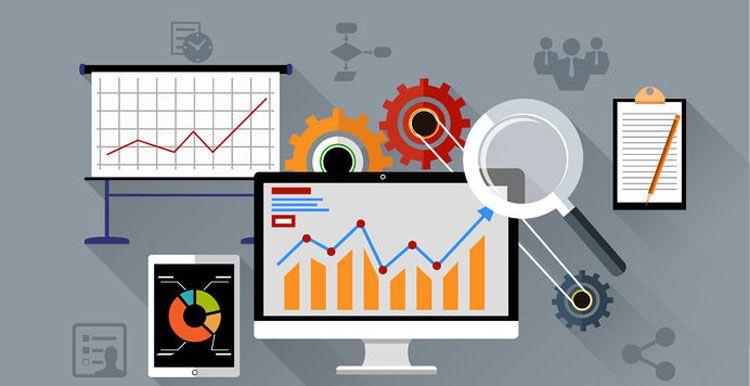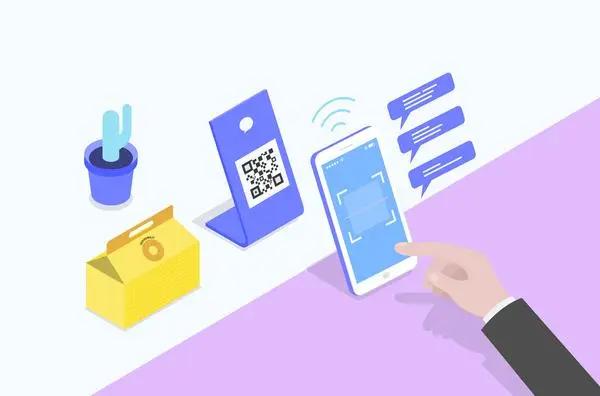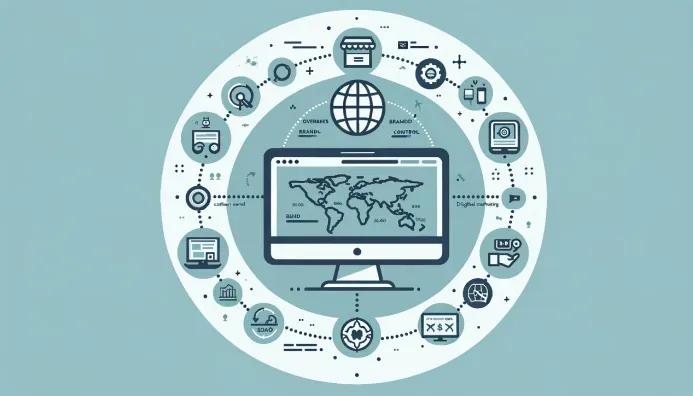效率工具

These 4 Marketing Trends Are Reshaping How We Connect With Customers
We surveyed 6,000 global leaders to find out how new technologies and expectations are changing the way businesses build relationships with customers. Here are the key findings and tips for success from our newest State of Marketing report.
Over the past few years, marketing trends have forced brands to navigate uncharted waters. Shifts in customer behaviours, an economy in flux, and emerging technologies are all rocking the boat.
You can help your company weather the storm by embracing tech tools, personalising your customer interactions, preparing for a cookieless future, and prioritising collaboration with remote teams. The key is to focus on the right solution for right now.
We’ve identified four major marketing trends from LIKE.TG’s latest State of Marketing report. These trends are changing the way we work and how we connect with customers.
Trend 1: Tools and trust are ASEAN marketers’ priorities and challenges
New challenges call for innovative solutions. As customer expectations shift, marketers are adapting to meet audiences’ new demands. More than 90% of CMOs around the world say they must continually innovate to remain competitive. Over the past year, marketing organisations have changed their top priorities to make this happen.
As businesses are charged with doing more with less, many ASEAN marketers are looking to leverage marketing tools and technologies. The ineffective use of these tools and technologies is also the top challenge for marketers in Indonesia, the Philippines and Thailand.
Trust is another major concern — consumers are growing increasingly uncomfortable with the way their data is handled. Many marketers are working on ways of reassuring their customers and using data responsibly. Marketers in Malaysia, the Philippines and Thailand listed issues relating to trust as their top priority.
Marketing tools
Technology adoption, vanity metrics, and a disconnection between marketing and sales can slow marketers down. Many marketers are further prioritising the modernisation of their tech stack, with significant numbers around the world investing in automation and employee productivity solutions. We’ve seen customers experience a 26% boost in productivity* thanks to Slack.
Customer data
The growth of martech tools has created more data than marketers can know what to do with. With more data generated than ever before, businesses are able to target customers with personalised experiences with much greater precision. However, marketers must manage the deluge of data types that come in and balance how to personalise without crossing the ethical line.
Quick tip
If you’re implementing new tech, make sure you don’t end up using it in the same way as the old solution. Martech data is only as good as how it’s shared and implemented. To translate technology investments into business value, you should focus beyond the platforms you’re using and ensure clear, cross-team visibility of your data. Ultimately, this will unlock your tools.
Trend 2: Marketers are redefining customer engagement with smarter, targeted interactions
Data has gone from being a supporting player in a marketer’s toolkit to a critical component in marketing strategy. Marketers need to get the most from technology that uses data to provide more personalised interactions. At the same time, you may find that costs are lowered and processes become more efficient. In fact, customers have told us that LIKE.TG marketing tools lower their customer acquisition costs by 27%*.
Marketing organisations around the world use the following technologies:
90% use a customer relationship management (CRM) system
89% use an account-based marketing (ABM) platform
62% use artificial intelligence (AI)
According to our report, 80% of marketers around the world say customer experience is a key competitive differentiator. They also say that they are hungry for more connected data in order to deliver better experiences. Marketing trends show that organisations continue to increase the number of data sources they’re using each year — with a projected total of 18 in 2023.
Marketers are using technologies like CRM systems and ABM platforms to unify data and deliver targeted campaigns, while leaning on AI to integrate automation into their marketing activities. Three of the top four AI use cases are related to automation, highlighting the importance of scaling up speed and effectiveness with existing resources.
Marketers are also focused on getting the most out of limited budgets and resources to meet audiences where they are. We found that 83% of marketers around the world say their marketing organisation engages customers in real time across one or more marketing channels.
Quick tip
If you want to fully understand your customers’ demands, you’ll need a new way of using the data you have. This is why integrated tech like customer data platforms (CDPs) are more relevant than ever. Using the insights provided by these platforms will help you optimise the critical moments in your customers’ journeys and build better marketing strategies.
Trend 3: The cookieless future is pushed back, but marketers continue to prepare
The decline of third-party cookies has led marketers to look for other sources of customer data. They’re pivoting to data given freely by customers (zero-party data) and data collected directly from customers (first-party data). Marketers we surveyed in Malaysia, the Philippines, Singapore and Thailand all said that they are providing incentives to their customers to share data. In contrast, marketers in Indonesia are concentrating on investing in new technologies.
As deadlines to phase out third-party cookies continue to be delayed, 75% of marketers worldwide say they still rely on third-party data. However, they aren’t allowing this to impede progress.
Our study shows that 68% of marketers around the world have created a fully defined strategy to shift toward first-party data as they adapt to changes in privacy regulations and calls for data transparency. Streamlining the number of data sources will also help marketers be more efficient and reduce costs.
While not all third-party data is cookie-related, marketers will need to reconcile this strategy with future changes in privacy regulations. Strategies such as providing information-sharing incentives for customers can help bridge the gap by enriching customer data profiles.
The growth of data sources in the near term highlights the need for technology that will help marketers combine multiple data sources into a single view of the customer. Current marketing trends back this up: Around the world, 32% of B2B marketers say that sharing a unified view of customer data across business units is a challenge. The numbers across our region paint a slightly different picture, with some marketers struggling more than others. Only 28% of marketers in Indonesia and the Philippines say that sharing data is a challenge, for example. The number climbs to 32% in Thailand, 35% in Singapore, and up to 45% in Malaysia.
Quick tip
As we approach a future without third-party cookies, you can start to incorporate more inbound marketing into your strategies. You can offer value through content and digital experiences in exchange for your audience’s consent to use their data. After years of investing in brand marketing across various platforms, this approach may feel like a complete turnaround for B2C marketers. But building owned digital experiences will still allow you to access valuable data — with complete control as an added bonus.
Trend 4: It takes more than an investment in tools to unlock collaboration
Remote work has fundamentally changed the marketing landscape, making collaboration that much more difficult. We found that 69% of marketers around the world say it’s harder to collaborate now than before the pandemic.
Many marketers continue to juggle communications, processes, collaboration, and problem solving, all while working in a hybrid world. And they believe this marketing trend is here to stay — 70% expect investments in remote technologies to be permanent. In response, marketers are investing in collaboration technologies to ensure that work gets done, regardless of location.
Marketers who said they use the following collaboration technologies:
Video conferencing: 46%
Channel-based collaboration platform: 45%
Instant messaging or chat apps: 45%
Enterprise social networks: 44%
Email: 43%
Shared documents: 42%
Voice messaging: 41%
Phone: 38%
Virtual whiteboards: 36%
Marketing organisations have adapted to the shifting needs of their workforce, adopting an average of four collaboration technologies to unify global marketing teams.
Taking the lead are technologies like video conferencing, channel-based collaboration platforms like Slack, instant messaging or chat apps, and enterprise social networks. While email makes it into the top five, it’s clear that communication tools that enable instant, asynchronous work are preferred when interacting with one another.
Quick tip
Integrating one platform that streamlines multiple applications and workflows can break silos and better coordinate marketing efforts. But it’s the adoption of the platform that can actually empower teams. Is the leadership team encouraging teams to use collaboration platforms, but are not actually using it themselves? Are content teams using one tool, but designers using another? To thrive in a work-from-anywhere world, collaboration requires an all-in approach to tools and processes that make teams agile and aligned.
This post originally appeared on the U.S.-version of theLIKE.TG blog. *Source: 2022 LIKE.TG Success Metrics Global Highlights study. Data is from a survey of 3,706 LIKE.TG customers across the US, Canada, the UK, Germany, France, Australia, India, Singapore, Japan and Brazil conducted between June 8 and June 21, 2022. Results were aggregated to determine average perceived customer value from the use of LIKE.TG. Respondents were sourced and verified through a third-party B2B panel. Sample sizes may vary across metrics.

Meet the New CFO — Your Most Important Leader in This Economy
Who has the most influence in a company? Increasingly, it’s the chief financial officer.
More CFOs are being promoted to CEO than ever before, according to new research. Approximately 8.1% of sitting CEOs came directly from a CFO chair.
The modern CFO manages more than just money. CFOs are taking broader leadership responsibilities, such as managing customer experiences, hiring and retaining talent, and leading strategic shifts into automation and other areas.
The CFO is a lifeline for company health — and becoming more critical as we head into a time of economic uncertainty. What does this mean for today’s CFO? How is this role evolving as businesses face ongoing disruptions and instability?
Changing characteristics of the modern CFO
CFOs are far more diverse in gender and race than CEOs (and the rest of the C-suite). This year, 16% of CFOs are women, up from 9.7% a decade ago. And 10.9% are racially or ethnically diverse, up from 3.6% a decade ago.
CFOs also have staying power, according to LIKE.TG research. CFOs remain in their positions for 4.8 years, on average — second only in tenure to the average 7.2 years notched by CEOs.
And they have more responsibilities in their evolving roles. For example, they must be:
Complex problem solvers
(Well informed) fortune tellers
Self-aware leaders
Expert delegators
“Traditionally, people have thought of CFOs as a steward” and that includes “running a tight finance ship,” Susan Li, Meta’s new CFO, said at a recent summit sponsored by Fortune. But today, CFOs wear many more hats, like “the efficient operator hat. The CFO is really a partner in steering the business direction and product vision for the company.”
At some companies, the expanding role of the CFO is removing the need for a chief operating officer, added Tracey Travis, executive vice president and CFO at The Estée Lauder Companies, who also attended the summit.
CFO challenges in 2023 — and beyond
The C-suite has relied heavily on CFOs in recent years to help lead in times of economic turbulence, and that will continue in the future. In fact, 75% of CFOs say economic disruption is 2023’s biggest challenge.
Another challenge is how to invest wisely in a downturn, especially in technologies that can help companies become more efficient as budgets tighten. The modern CFO who understands the potential of strategies like automation and platform consolidation can positively affect the bottom line.
The average company uses 976 applications to run its business and store customer data. This isn’t efficient, effective, or affordable.
If CFOs don’t have access to data across the whole business, how can they make informed decisions? The modern CFO must be a digital native — and that comes from deep understanding and partnerships with the CIO and tech team.
The key is focusing on technology investments that deliver value, long-term cost savings, and ultimately, solid ROI. How can companies make the right technology investments during a downturn to deliver long-term value? LIKE.TG COO Brian Millham suggested the key is to lean into efficiency — simplifying complex processes and creating better productivity pathways.
“It is possible to cut costs and reduce complexity while creating resilience within your company,” he added. “You can do this without compromise by consolidating systems and investing in the right technology for your business.”
Skills for the modern CFO
Spreadsheets are still important, but today’s CFO needs to communicate beyond the numbers.
“CFOs are viewed as kind of a deputy CEO,” Alyse Bodine, global head of the financial officers practice at recruiting firm Heidrick Struggles, told Fortune last month. “The ability to lead a diverse set of individuals, both finance and non-finance, across the organisation takes people skills. So, there’s definitely a heightened demand on that skill set when it comes to the finance population.”
LIKE.TG completed hour-long interviews last year with 10 CEOs across enterprise and commercial business. Many said they expected to replace current C-suite team members with leaders who had higher emotional intelligence (EQ) and were better equipped to handle not only stressed employees but a more socially engaged workforce.
This isn’t new news. In 2020, Summit Leadership Partners found that 80% to 90% of high performers in the C-suite were differentiated by high EQ. According to their research, EQ is twice as important for predicting performance in executives than technical skills or IQ.
And EQ could bridge the Great Disconnect between employees and the C-suite.
How CFOs can evolve
It’s no longer enough to steer a finance ship well. As CFOs develop new leadership styles, they should ask themselves the following questions:
Is the way I lead:
making the company stronger?
true to who I am?
necessary to get the job done?
It takes a different lens to solve today’s — and tomorrow’s — problems. The modern CFO who can think creatively and differently, and develop thoughtful strategies for investing, is well poised for the road ahead.
Ultimately, it’s the CFO who signs off on major investment decisions and takes the risk of investing in innovation versus tightening belts. Leaders should bet on the CFO that invests in the future versus pausing progress.
Download our ebook to learn how toPrepare your Business for a Digital Futuretoday.
This post originally appeared on the U.S.-version of theLIKE.TG blog.

Drive Cost Savings for Your Business With These 5 Winter ’23 Innovations
Innovation is a top priority at LIKE.TG. In fact, innovation is one of our core values, and it’s reflected in everything we do.
We release new innovations three times a year, many of which come from ideas and feedback received directly from our customers via the IdeaExchange. And we know that there’s no better time to listen to our customers than right now.
In a time of economic uncertainty, our customers told us that getting the most out of their LIKE.TG investment is more important than ever. So, we’ve put together a list of ways you can use our Winter ’23 innovations to drive cost-saving and efficiency for your business. This new release will also help you maximise your LIKE.TG investment.
Guide
Guide to data security and governance
GET THE GUIDE
Guide
IT leader’s complete guide to low code
GET THE GUIDE
1. Create preventative maintenance plans
Service Cloud Preventative Maintenance enhancements let you create preventive maintenance plans for equipment based on usage. This keeps your customers updated at all times. The next maintenance can either be determined by fixed cadence or it can be automatically adjusted based on the usage when the previous work was completed. These enhancements will enable better maintenance planning, repair time, and integration into the scheduling process, significantly reducing unnecessary spare parts expenditure and labour costs. window.SfdcWwwBase && window.SfdcWwwBase.videoComponent && window.SfdcWwwBase.videoComponent.updateChapter(document.scripts[document.scripts.length - 1].getAttribute("data-uuid")); if(!window.vidyardEmbed){ window.videoUtils && window.videoUtils.loadScriptOnce("https://play.vidyard.com/embed/v4.js", "Vidyard", true); } else { window.vidyardEmbed.api.renderDOMPlayers(); } (function($) { // Add 'Configuration' global object with details of our Adobe Analytics instance window.Configuration = window.Configuration || {}; var rsid = (typeof Server !== 'undefined') ? Server.getAccount() : ''; $.extend(window.Configuration, { PUBLISHER: '8D6C67C25245AF020A490D4C@AdobeOrg', MCID: '8D6C67C25245AF020A490D4C@AdobeOrg', NAMESPACE: 'LIKE.TG', CHANNEL: 'LIKE.TG', RSID: rsid, TRACKING_SERVER: 'LIKE.TG.sc.omtrdc.net', HEARTBEAT_TRACKING_SERVER: 'LIKE.TG.hb.omtrdc.net', DEBUG: false }); }(jQuery)); // End of IIFE
2. Enrich profiles with cloud storage
CDP Connector for Google Cloud Storage, a new Marketing Cloud feature, reduces integration and maintenance costs. It leverages a pre-built connection to bring data from Google Cloud Storage into Customer Data Platform. Now, you can leverage cloud storage attributes to enrich customer profiles and optimise segmentation and personalisation.
Deliver success now
Learn how Customer 360 helps you increase efficiency, improve results, and lower costs.
Start now
3. Do more with commerce
New enhancements to B2B and B2B2C Commerce help you:
Enable recurring revenue models for B2B and B2B2C using Subscription Management’s pre-built integrations that connect Revenue Cloud to Commerce Cloud.
Enable shoppers to quickly search for products on B2B websites and gain more insight into shopper intent with Semantic Search.
window.SfdcWwwBase && window.SfdcWwwBase.videoComponent && window.SfdcWwwBase.videoComponent.updateChapter(document.scripts[document.scripts.length - 1].getAttribute("data-uuid")); if(!window.vidyardEmbed){ window.videoUtils && window.videoUtils.loadScriptOnce("https://play.vidyard.com/embed/v4.js", "Vidyard", true); } else { window.vidyardEmbed.api.renderDOMPlayers(); } (function($) { // Add 'Configuration' global object with details of our Adobe Analytics instance window.Configuration = window.Configuration || {}; var rsid = (typeof Server !== 'undefined') ? Server.getAccount() : ''; $.extend(window.Configuration, { PUBLISHER: '8D6C67C25245AF020A490D4C@AdobeOrg', MCID: '8D6C67C25245AF020A490D4C@AdobeOrg', NAMESPACE: 'LIKE.TG', CHANNEL: 'LIKE.TG', RSID: rsid, TRACKING_SERVER: 'LIKE.TG.sc.omtrdc.net', HEARTBEAT_TRACKING_SERVER: 'LIKE.TG.hb.omtrdc.net', DEBUG: false }); }(jQuery)); // End of IIFE
4. Spot bottlenecks and collaborate from anywhere
Users can now collaborate faster by completing tasks in Experience Cloud using Flow Orchestration enhancements, specifically Flow Orchestration’s Work Guide. In addition, admins can empower other users to help spot bottlenecks and fast-track work using supervisor permissions. You can now allow anyone to participate in workflows from anywhere. window.SfdcWwwBase && window.SfdcWwwBase.videoComponent && window.SfdcWwwBase.videoComponent.updateChapter(document.scripts[document.scripts.length - 1].getAttribute("data-uuid")); if(!window.vidyardEmbed){ window.videoUtils && window.videoUtils.loadScriptOnce("https://play.vidyard.com/embed/v4.js", "Vidyard", true); } else { window.vidyardEmbed.api.renderDOMPlayers(); } (function($) { // Add 'Configuration' global object with details of our Adobe Analytics instance window.Configuration = window.Configuration || {}; var rsid = (typeof Server !== 'undefined') ? Server.getAccount() : ''; $.extend(window.Configuration, { PUBLISHER: '8D6C67C25245AF020A490D4C@AdobeOrg', MCID: '8D6C67C25245AF020A490D4C@AdobeOrg', NAMESPACE: 'LIKE.TG', CHANNEL: 'LIKE.TG', RSID: rsid, TRACKING_SERVER: 'LIKE.TG.sc.omtrdc.net', HEARTBEAT_TRACKING_SERVER: 'LIKE.TG.hb.omtrdc.net', DEBUG: false }); }(jQuery)); // End of IIFE
5. Increase automation and customer retention
Enterprise Self-Service for Communications Cloud allows you to eliminate steps, scale transactions, and improve customer satisfaction. It automates move, add, change, or delete services (MACD) for bulk and multi-site subscription management. In turn, this will help you reduce cost-to-serve, while increasing automation and customer retention. window.SfdcWwwBase && window.SfdcWwwBase.videoComponent && window.SfdcWwwBase.videoComponent.updateChapter(document.scripts[document.scripts.length - 1].getAttribute("data-uuid")); if(!window.vidyardEmbed){ window.videoUtils && window.videoUtils.loadScriptOnce("https://play.vidyard.com/embed/v4.js", "Vidyard", true); } else { window.vidyardEmbed.api.renderDOMPlayers(); } (function($) { // Add 'Configuration' global object with details of our Adobe Analytics instance window.Configuration = window.Configuration || {}; var rsid = (typeof Server !== 'undefined') ? Server.getAccount() : ''; $.extend(window.Configuration, { PUBLISHER: '8D6C67C25245AF020A490D4C@AdobeOrg', MCID: '8D6C67C25245AF020A490D4C@AdobeOrg', NAMESPACE: 'LIKE.TG', CHANNEL: 'LIKE.TG', RSID: rsid, TRACKING_SERVER: 'LIKE.TG.sc.omtrdc.net', HEARTBEAT_TRACKING_SERVER: 'LIKE.TG.hb.omtrdc.net', DEBUG: false }); }(jQuery)); // End of IIFE
Drive cost savings and transform your business using brand new features from theWinter ’23 release.
Find out more
Check out these other posts to learn more about our products:
What is LIKE.TG Genie?
What Is a CDP?
What is LIKE.TG Customer 360?
This post originally appeared on the U.S.-version of theLIKE.TG blog.

10 New Findings Reveal How Sales Teams Are Achieving Success Now
Our recent State of Sales survey, featuring insights from more than 7,700 sales professionals, shows how teams are maximising value amid economic headwinds.
There’s one thing that’s certain in sales: things are never certain. That’s underscored in our latest State of Sales report, which found 72% of sales professionals don’t expect to hit their annual quota. Why? Challenges like inflation, the continuing effects of the pandemic, and supply chain breakdowns are ever-present.
The good news is sales teams are finding ways forward by maximising efficiency, cutting costs, and boosting sales rep productivity. Here are ten stats from our State of Sales report that tell the story of sellers adapting to meet the moment.
State of Sales highlights
1. 70% of sales leaders say their company takes fewer risks now than before the pandemic
Despite economic uncertainty, companies still need to hit their targets. Instead of gambling on higher-risk strategies and tactics, sales leaders are focusing on what they know works. In fact, 55% of sales leaders say they’re prioritising low-risk initiatives with guaranteed modest growth. The headline message is that sure bets are preferred over bigger, but more uncertain gains — especially in rocky times.
2. Sales reps spend only 28% of their week selling — down from 34% in 2018
Sales teams are being asked to cope with too much manual work. Sellers want to sell, but they spend nearly three-quarters of their time distracted by admin. This includes tasks like record keeping, solving broken processes, tool management, data entry, and lead management. This creates a hurried sales process and less time to hit quota.
3. 66% of sales reps say they’re drowning in tools
Jumping between different sales tools is a big reason reps don’t spend enough time selling. On average, sales teams use 10 tools to close deals. Many of these have a role to play in the sales process, but they can be costly, hinder productivity, and take reps away from connecting with prospects and customers that move deals forward.
4. 94% of sales organisations plan to consolidate their tech stack in the next 12 months
To address tech overload, sales organisations are looking to streamline their stack. But the way forward isn’t simply ditching tech. It’s about optimising critical tools and removing nonessential or redundant ones. Sellers indicate there’s plenty of opportunity here — only 37% strongly agree that their organisation takes full advantage of their CRM.
George Carrera III, Senior Manager of Systems Technology at Mitsubishi Elevators, emphasises the importance of both consolidation and optimisation, “As sales teams look for new paths toward efficiency, endless technical solutions are often viewed as silver bullets. But you have to analyse your process to see what’s really needed, make the most of tools you need to keep, and cut legacy tools that don’t help.”
5. 97% of sales leaders and sales ops professionals say AI has improved use of reps’ time
Not only are sales organisations working to consolidate tech stacks to boost efficiency, they’re also keen to remove the manual work that keeps sales reps from spending time selling. Artificial intelligence (AI), paired with automation, removes admin tasks like updating deal records and scoring leads. This keeps sellers focused on conversations with buyers. This isn’t just a theoretical productivity booster, either — as our report reveals, high-performing reps are 1.9x more likely to use AI.
6. 90% of high-performing sales reps say their leadership encourages them to prioritise long-term customer relationships over short-term wins
Facing uncertainty, sales leaders are looking for revenue they can rely on. That’s why they’re emphasising customer relationships over quick deals, allowing reps to build solid connections that foster loyalty, leading to cross-sells, upsells, and renewals. All these lead to more predictable revenue.
To establish these relationships, reps are increasingly acting as more than just transactional salespeople. In fact, 82% of sales reps say their company enables them to act as trusted advisers to buyers, helping them solve complicated problems and address their customers’ specific needs.
7. 81% of sales representatives say team selling helps them close deals
Sellers are also adapting to increasingly savvy buyers. 81% of sales reps say buyers are increasingly conducting research before they reach out, which means sellers must pool resources and knowledge to address questions that go beyond basic product functionality.
Unfortunately, cross-functional alignment could use some work. Most reps agree team selling helps them close deals, but say it’s tricky for everyone to sync up. Addressing this will be top of mind for sales leaders, who say cross-functional alignment is the #1 tactic for driving growth.
8. 85% of sales leaders say they’re struggling to get budget for needed headcount
Tight budgets are increasingly an issue for sales leaders, which adds stress to teams asked to hit revenue targets without added headcount or resources. This can lead to frustration and, in more than just a few cases, turnover.
That’s why it’s important to make sure every rep has the resources and support they need to be successful. Leaders are keeping employee experience and engagement top of mind, offering regular one-on-one coaching, increasing tool training, prioritising work-life balance, and offering more benefits.
9. 81% of sales reps say they get valuable coaching from their manager
That’s the good news. The problem is one-on-one coaching is relatively infrequent — only 26% of sales professionals say it occurs weekly. And when managers do sit down with reps, they likely have a lot to cover.
One possible solution is enablement technology that automatically surfaces big-impact areas for training. It’s a big area of opportunity, as only 53% of sales leaders say they use coaching solutions like this.
10. Only 28% of sales professionals expect to meet or exceed quota in the following year — but sales organisations are offering support
With so much global economic uncertainty, sales professionals worry about hitting revenue targets. But it’s not all bad news. Even facing very real financial difficulties, 75% of reps have confidence in their organisation’s ability to prepare them for the current selling landscape.
Sales statistics to drive success in a new era of efficiency
Winning sales leaders know they can excel in lean times if they emphasise efficiency and productivity. Our State of Sales report underscores this, with sales leaders saying their focus over the next 12 months will be on:
Embracing hybrid and virtual selling for more flexibility
Improving cross-functional alignment
Maximising the use of tools and technology
These will be key to driving success in 2023 — and are instrumental in ensuring success now.

4 Steps to Help You Build a Resilient Marketing Strategy
Nearly every business is worried about — or already facing — slowing or declining revenue growth, as many experts feel we’re heading toward challenging times. With this, the “growth at all costs” mantra of the past decade is quickly shifting to one of business resiliency and sustainable growth. Resilient marketing focuses on the ability to absorb stress, maintain healthy business operations, and adapt to new conditions.
Businesses that focus more on long-term sustainability can emerge from the current economic climate stronger than they were before.
These are 4 ways leaders can build resilient marketing in their organisations.
1. Realise how resilient marketing helps optimise your marketing spend
Marketing budgets are often under increased scrutiny during economic uncertainty. You’ll need to defend your marketing efforts by validating their impact and demonstrating clear results.
Yet, 80% of marketers say their ability to track return for each marketing investment needs improvement. Investing in data analytics capabilities can help you:
Make the most of your marketing budget
Reallocate spend from low-performing campaigns
Quickly adjust current campaigns
Suppress marketing messages for customers with open service cases
Clearly demonstrate your team’s impact on revenue
2. Evaluate the efficiency of your current systems — and cut what doesn’t work
You’ve probably already felt the increased pressure to more strictly control — and in many cases — reduce marketing costs. Marketers are looking to reduce their spending on campaigns that aren’t resonating with customers and move that money toward bigger initiatives.
A great place to start is by evaluating your marketing technology tools to see how well they’re still working for you. Has this become increasingly complex and bloated over the past decade? Marketing teams use 23 different marketing systems, on average. Begin by evaluating your tech stack to identify redundancies, inefficiencies, and tools that your team doesn’t really use anymore. Identify areas where you can:
Consolidate systems and contacts
Eliminate inefficient tools
Reduce maintenance support costs
3. Find more efficient ways to achieve your goals, despite shifting budgets
Most marketing organisations are not growing as fast as they previously hoped, and in many cases they are shrinking. You may be grappling with how to make your department more efficient and agile in these rapidly-changing times.
For example, 29% of marketers spend at least one week or more every month preparing data — that’s time that could be better spent developing and executing resilient marketing strategies. To remain agile as marketing budgets shift, you need to make every marketing moment count:
Automate time-consuming, error-prone tasks like Excel-based data integration and reporting, so your team is free to focus on bigger problems
Identify strategies to scale personalisation efforts, like using AI to tailor newsletter content to each reader, improving campaign effectiveness
Hold a call with your marketing team to identify bottlenecks like requiring IT to make basic changes to campaigns, so you can improve speed of campaign execution
Explore ways to better collaborate with remote teams, ensuring everyone is on the same page
Find ways to streamline your operations, placing a focus on agility. This way, you’ll be prepared — not panicking — when things change.
4. Lead with the value to the consumer
As new customer acquisition becomes more challenging during economic uncertainty, marketers should adopt a strategy that focuses on retaining current customers and making sure they feel they’re getting the most value. This helps protect existing revenue and is one of the surest paths to continued growth during times of uncertainty.
To help customers get the most value from your products, you should consider investments in the following areas:
Developing a first-party data strategy, making better use of data you collect from customer interactions
Making sure customers have what they need after the sale, anticipating needs such as onboarding, education or complementary products
Identifying and re-engaging customers who are undecided about purchasing
Improving customer experience through real-time personalisation
Starting a customer loyalty program
Building immersive and customer-first experiences, such as augmented and virtual reality
Keep your focus on moving forward
It can be tempting to pause innovation during times of economic uncertainty. However, research from McKinsey says otherwise. They found that organisations that maintained their focus on innovation throughout the 2009 financial crisis outperformed the market average by more than 30% in the following three to five years.
Marketing leaders need to act now to optimise marketing spend with a slimmer budget, improve adaptability, and work to keep current customers. Resilient marketing helps grow revenue and profitability while also giving your team the ability to innovate and outperform your competition in the long run.
Dive deeper into all the trends and insights shaping the marketing landscape.
Download the Marketing Intelligence Report. This post originally appeared on the U.S.-version of the LIKE.TG blog.

LIKE.TG Live: Asia — It’s a New Day for Customer Magic
It’s been a year of change for LIKE.TG, and for our customers, but now it’s a new day. We have an opportunity to reflect on how we’ve been doing and also look to the future.
LIKE.TG Live: Asiabrought the best of Dreamforce right to you. It’s your chance to hear from Trailblazers from all over the region, learn from industry experts, and find out the latest product innovations that we have for you.
We’ve brought together the whole LIKE.TG family — including Slack, MuleSoft, and Tableau — to help you grow your business. You’ll discover exciting new ways to build a more resilient business by increasing efficiency and productivity — all with the power of LIKE.TG Customer 360.
Watch LIKE.TG Live: Asia on demand for our amazing showcase. Together, we’ll learn, be inspired, and discover new ways of working.
What’s happening at LIKE.TG Live: Asia?
Dreamforce 2022 was a celebration of learning, connection, and change. We’ve collected together the highlights, including inspiring customer stories and product demonstrations. By the end of the show, you’ll know how you can combine data, innovation, and a digital HQ to take the next step toward delivering customer magic.
Here’s a quick list of what you can expect to see:
Magical innovation with Genie and Customer 360
Introducing LIKE.TG Genie — the real-time platform for customer magic.
LIKE.TG Genie is a gamechanger for Customer 360. We’ll show you how it can bring real-time data to your CRM, providing the most up-to-date picture of your customers, across every single Cloud in the Customer 360 platform.
There will be demonstrations of how Genie can transform how you provide personalised sales experiences for your customers, segment your marketing data for even better campaigns, and revolutionise your reporting in Tableau.
You’ll also see how Customer 360 powers everyday business in several customer demos, including Singtel, Aureus Group, and Starbucks.
Inspiring Trailblazer stories
We’ll be sharing inspirational stories from Trailblazers who are helping others to learn, connect, and give back.
We’ll be talking to Joanna Teo, Managing Director of Attribute Data, who will share her journey as a Trailblazer, including advice for Trailblazers who are just joining the community.
We’ll also talk to three customers as part of our panel on Innovation as a Growth Strategy:
Jessica Noble, GM IT Business Partner, International SOS
Wan Irfan Wan Ismail, Head of Corporate Platform Services, PETRONAS
Umesh Ramakrishnan, Data Manager, Traveloka
Innovation is often seen as a critical strategy in driving growth, but it can be difficult to find the time and focus needed to make it happen. Our guest Trailblazers will describe how:
Their organisations have embraced innovation as a growth strategy
Data has played a role alongside innovation
They keep innovation on the agenda in a world of competing priorities
Help the planet with Net Zero Marketplace
Sustainability is at the heart of what we do at LIKE.TG. We need to take action now to ensure that we can tackle climate change together. We can’t do everything, but together, as Trailblazers, we can combine our efforts to help our planet.
Sujith Abraham will describe how Net Zero Cloud can help your business go carbon neutral faster with state of the art data tracking. He’ll also introduce Net Zero Marketplace — a new way for organisations to trade carbon credits.
A new approach to teamwork with Slack Digital HQ
In a recent Bloomberg poll, more than 40% of respondents in Singapore said that they would turn down a job offer if it didn’t include the chance to work from home.
This new way of thinking about how we work requires a new approach to team collaboration. As individuals, we’ve changed the way we approach our work, and it’s time for organisations to change the way they think too.
The answer? A Digital HQ, powered by Slack. We’ll reveal new integrations and functionality that is making Slack simpler, more productive, and more enjoyable to use.
We’ll also show you exactly how these new capabilities will fit into your Digital HQ with a full demonstration from Slack’s Lead Solution Engineer, Shankar Krishnamurthy.
Make data-driven decisions with MuleSoft and Tableau
More than 80% of CEOs have told us that they want their organisations to be more data-driven. But only around 30% of employees think that their company is using data to inform decision making.
There is clearly a gap between ambition and execution. Data can be hard to access, and even harder to understand. MuleSoft and Tableau can help, first by connecting all your data sources with your single source of truth, and then empowering you to share insights in an easy-to-understand format.
Tune in to learn more about how these tools can take your data-driven decision making to the next level.
Small Business Showcase
LIKE.TG Live: Asia doesn’t end there. We are excited to share our Small Business Showcase, with advice on how to find, win, keep, and grow customers.
LIKE.TG expert Stoyan Licina will be on hand to show you how you can put customers at the heart of everything you do with Customer 360.
Licina will share how you can leverage marketing automation to:
Find more qualified sales leads with smarter lead generation
Win more deals with an end-to-end customer view and make your sales teams more productive
Keep your customers happy by providing exceptional customer service at every touchpoint on their journey
Grow your customers with AI-data-driven decisions insights
And to finish the day, Gerald Tjan, Manager Small and Medium Business at LIKE.TG, will sit down with Ying Da Teoh and Ivy Wu from Aureus Group. They will talk about the power of technology to transform the way small and medium sized businesses can work. They’ll also be sharing a demonstration of how they use LIKE.TG to offer exceptional experiences to their 18,000+ students.
Want to know more?
No matter where you are on your journey, LIKE.TG Live: Asia will show you how to ‘wow’ your teams with transformational ideas and be the changemaker who delivers success.
Watch on demand:
LIKE.TG Live: Asia –It’s a New Day for Customer Magic (Main)
LIKE.TG Live: Asia –Small Business Showcase

3 Ways To Promote Efficient Growth With Resources You Already Have
“Our selling motions may never be the same.”
“Competitive intensity is only going to increase … we could fall behind.”
“We will have to do more with less given hiring and spending freezes.”
Those are among a handful of common concerns we hear from sales leaders these days — many of whom are responsible for promoting efficient growth, even as we face economic uncertainty.
Sales leaders will need to zero in on where they and their teams can increase efficiency, manage risk, and most importantly, drive revenue. They will need to relentlessly prioritise, deploy effective tools for sellers, and train their sales reps on new skills required in the current selling environment.
The following are a few strategies our customers use to meet the challenge:
1. Promote efficient growth by focusing on high-potential and high-revenue accounts
Sales is all about telling the right person the right story at the right time. In a “do more with less” environment, sales teams must focus on the best markets, accounts, and decision makers to pursue.
This prioritisation requires an intelligent approach that relies on data. Some customers leveraged predictive insights to determine which deals might get pushed into the next quarter. They then developed recovery plans to speed up deal closures and capture millions of dollars in revenue in the current quarter.
Here’s how it works:
Regrade and rescore your accounts based on current revenue and future potential. Plot each of your accounts on a 2×2 matrix from low to high, with future potential on the vertical axis and current revenue on the horizontal axis.
Determine your highest-priority accounts. From the matrix above, your main focus should be on the top two quadrants: customers with high future potential and high revenue. For each of those quadrants, you want to determine if you have the right sales coverage and resourcing, which might require rolling out new sales or communication channels for easier customer engagement and folding in more reps to handle complex accounts.
For high-priority accounts, develop strategic account plans to uncover new sales opportunities. The account plan doesn’t need to be lengthy, but should include an executive-level account overview, key sales goals and objectives, top opportunities for the year, and a relationship plan (how you intend to communicate with account stakeholders). From a plan execution standpoint, you should include the account team roles and responsibilities, a meeting cadence, and an overall action plan. At a minimum, sales leaders should review the plan on a monthly and quarterly basis.
Leverage an integrated tool with automation, AI, and real-time data to track account progress and performance. The tool should include insights across marketing, sales, and service — or at least seamlessly integrate with tools used in these departments. To make it as effective as possible, make sure it automates manual tasks and communications, and offers intelligent insights so sellers can prioritise the best opportunities as soon as they arise. If you already have a CRM, check to see if it has this functionality — some include it as part of the core platform.
2. Simplify your sales tech stack
Our latest State of Sales report revealed something alarming about sales reps: most of them spend only a third of their time selling. The other two-thirds is spent juggling manual tasks like data entry and deal record management in outdated CRMs and countless other, disconnected tools. The solution? Streamlining and optimising tech. Some of our customers have reduced costs by hundreds of millions of dollars by standardising and simplifying their systems.
To do the same for your business, consider taking the following steps:
Outline each system or tool involved in the sales process.
Determine how much each tool is used during the sales process as a proxy for value. Generally, unused tools — or tools with a lot of unused features — signal low value.
Create a plan to sunset systems and tools that add little value to the seller or process.
A tool by itself will not drive results, but seeing a rep in action, powered by their systems, can drive the kinds of impact leaders are looking for.
To commit to long-term and lean productivity, strengthen your sales operations — if you haven’t already. With a keen eye on process efficiency and streamlining technology (leveraging the latest in automation and AI), sales ops teams can make sales predictions more accurately.
(Also, read about how startup Anduin Transactions approached streamlining its sales operations.)
3. Minimise business risk by focusing on customer and employee satisfaction
Without surplus financial resources, risk can increase. You lack the room for error to make a bad acquisition or launch a nice-to-have marketing campaign or product. That surplus is only possible when revenue is stable, and stable revenue is only possible when customers are satisfied and top-performing talent is retained. That’s why you need to make sure both customers and your employees are happy. Here’s how:
For your talent: Survey your sales teams to gauge levels and areas of dissatisfaction. As needed, execute any necessary retention strategies that address these areas of concern. For example, if your reps are frustrated with low pay, consider multi-year bonuses. If sales reps are wondering how to progress in their careers, roll out new professional development opportunities like classes and seminars.
Also, be sure your reps have everything they need to succeed in their day-to-day work by setting up enablement programs with the right onboarding, coaching, training tools, and resources. Studies show that if you give them everything they need to sell more, faster from the get-go, they’re more likely to stay.
For your customers: First and foremost, train your reps to engage customers beyond the sale. Give them ownership over the customer relationship so they track progress both up to the sale and after the deal is completed — ensuring service, billing, and all other team interactions are exceptional. Encourage regular check-in calls or communication, even if the customer doesn’t reach out with an ask. This makes them feel valued, which encourages loyalty and creates lasting relationships.
To get a sense of customers who might be ready to leave for the competition, look at data such as past buying behaviour or service issues. For example, a customer who stops buying as frequently or as much as they once did may be at risk of defecting. They may also be contacting the service centre more and have an increasing number of support cases. Be proactive about addressing these issues — prioritise reaching out to customers whose behaviours have changed or who need some extra help.
Next steps for efficient growth:
Driving efficient growth in times of change is ultimately achieved by returning to the basics. Most importantly, remain focused on the accounts that fuel revenue, cut back on tech that doesn’t serve you, and take care of your customers and employees. Also, be ready to adjust strategies and processes when they aren’t working. If you can achieve this, not only will you perform better during a downturn, but you will set yourself up for efficient growth whenever market conditions fluctuate.

Meet Vishal Salunkhe: Creating Magical Customer Experiences
At LIKE.TG, Nichola Palmer works with customers to bring their stories of innovation and transformation to life. In this blog series featuring Trailblazers, Nichola introduces Vishal Salunkhe,Vice President Regional Head of Sales Strategy Operations at Carousell Group. Vishal has spent his career helping companies create intuitive customer experiences that put the magic back in the sales process. Vishal Salunkhe has been fascinated by technology for as long as he can remember. Growing up in Bombay, he was an early adopter from childhood, and remembers his desire to be the first in his class to own a mobile phone.
“I saved my pocket money for six months, and I’m sure I skipped meals to get that phone,” he laughs. “Whether it was arcade games, or new apps or even MySpace, I was always very technologically curious.”
Vishal puts his childhood fascination with technology down to the magic of user experience. Understanding the mechanics of that experience has been a theme that has run through his career.
“In my early adulthood, I began to understand that technology is all about solving user problems in a meaningful way,” he says. “That’s the most attractive part of technology for me. There’s an ‘a-ha’ moment that comes when you see how technology is used to solve a problem that you didn’t even know you had.”
Building a strong foundation
As a student, Vishal was interested in economics. He attended the Indian Institute of Planning and Management for his postgraduate studies, and completed a Master of Business Administration (MBA) at the International Management Institute.
“I was lucky to join a business school that had one of the most intensive and diverse economics curriculum,” he says. “We studied everything from behavioural economics to business economics, and I still see that play out in the foundation of a lot of things I do today.”
Vishal also developed an interest in philosophy. He was particularly attracted to objectivism and the work of Ayn Rand.
“Objectivism essentially frames achieving our own happiness as the moral purpose of our lives, and productive achievement as our noblest activity,” he explains. “I feel these ideas are the foundation of my life and work philosophy.”
Putting philosophy to work
It’s no surprise that Vishal excelled in his first professional role as a Sales Operations Analyst at one of the top-five tech companies in India. His grounding in technology, economics and philosophy proved to be an ideal formula for the budding young sales professional.
“I realised that I could only become a good salesperson by solving customers’ problems versus the hard sell,” he says. “Selling becomes very easy because when you are just trying to solve a problem for the customer it’s not really a sale. It becomes a partnership, and the sale is just the output of a successful partnership.”
Vishal wanted to work across a spectrum of different big-tech software companies, and that journey led him to sales operations and service improvement roles at IBM, A.P. Moller – Maersk, and Red Hat. Today, as Vice President Regional Head of Sales Strategy Operations at Carousell Group, Vishal has shifted his focus to the consumer space.
“Carousell was a pivotal shift in my career,” he says. “I felt that I had achieved everything I could in sales operations at an enterprise level, and Carousell was an opportunity for me to switch focus from the B2B enterprise space to B2C.”
Solving user problems
Vishal’s transition to Carousell also came with a move to Singapore, and the opportunity to set up the company’s sales enablement and CRM processes. The role aligned with his core passion for the problem-solving magic of good user experience.
“Accepting the role was a no-brainer for me,” he says. “It is an opportunity for me to create, rebuild and polish our solutions to deliver that magic user experience in ways that solve user needs, and are successful for the business.”
But Vishal knows you need the right tools for the job. He says the pandemic taught him about the need for collaboration — and the importance of having the tools that make organisation-wide collaboration possible.
“I joined Carousell in March 2020, and within one week half the world was locked down,” he says. “There was so much behind-the-scenes strategy and go-to-market collaboration that needed to happen to get to a point where we could be meaningfully solving user problems.”
Finding the magic
Vishal says LIKE.TG has been instrumental in fostering this kind of organisation-wide collaboration. Customer 360 has replaced disparate sources of data to align employees around a single view of the customer, and streamlined the workflows that deliver magic user experiences.
Vishal’s first experience with LIKE.TG was during his time at A.P. Moller – Maersk where he helped migrate a legacy CRM into LIKE.TG. He was hooked on the ease of working with the platform and with the insights it provided. “LIKE.TG is a breath of fresh air in terms of its user experience. The dashboard interface is so intuitive, and it’s so fast to build processes for our sales leaders. You need those kinds of tools in order to deliver the magic moments to your customers. In fact, some of my career choices have been led by whether my potential employer uses LIKE.TG.”
LIKE.TG’s user experience, says Vishal, is an example of the intuitiveness Carousell is building into the company’s own user interface.
“That’s the other piece of the puzzle,” he concludes. “You can build a very beautiful product that meaningfully solves customer problems. But if the user doesn’t intuitively understand how to use it, then it’s worthless. The user should be able to intuitively use 70 percent of your product in a matter of seconds, without training. That’s where the magic lies.”

How PPIS Is Using LIKE.TG To Build Stronger Communities in Singapore
Persatuan Pemudi Islam Singapura (PPIS), or the Singapore Muslim Women’s Association, (PPIS) has been empowering women, children, and families since 1952. The non-profit organisation is striving to build stronger, more supportive communities with a range of services including childcare support, early childhood education, after-school care and enrichment, family casework and counselling, and fostering.
That’s an ambitious mission, and PPIS has embraced digital transformation to achieve it. The organisation is using LIKE.TG to optimise and automate donation, volunteer and event management workflows to increase productivity, boost efficiency, and get the most value out of its resources.
Transitioning from manual paper-based workflows to digital processes has required an organisation-wide shift across a network of 17 PPIS centres spread throughout Singapore. It’s a project that Thariq Aziz, Senior Manager IT Facilities Department at PPIS, says needed to start with basic digitisation.
“When I joined PPIS in 2019, the workflows were very manual and paper-based,” he explains. “It required lots of filling out physical forms and signing off with wet ink. There was no such thing as digital signatures, and no Zoom. Donations, volunteers, and counselling were managed in Excel spreadsheets.”
The transformation journey begins
For the organisation’s digital transformation to be effective, Aziz knew processes need to come before tools. So he took a step back and put time into researching departmental workflows and identifying where and how digital tools could add value.
His first stop was the Human Resources (HR) department. Digitising forms and signoffs with web-based applications achieved early success transitioning away from manual, paper-based workflows. But that was only the tip of the iceberg.
“That early digitisation led us to LIKE.TG’s Nonprofit Success Pack (NPSP),” Aziz says. “Our first deployment was a client management system (CMS) for SYM Academy that’s responsible for all our family counselling and therapy services. Prior to LIKE.TG, clients were tracked in Excel and session notes were recorded in Word. LIKE.TG enabled us to bring this all onto a single CMS platform.”
The new Salesforce-based CMS gave Aziz the proof of concept he needed to expand the organisation’s digital transformation. So he hired Farique De Silva, Project Manager CRM at PPIS, to lead the next major LIKE.TG deployment. That came in the form of a new customer relationship management (CRM) platform for the donations department.
A single source of donor interaction
Farique explains that donation volume is seasonal, so PPIS needed a CRM that could effectively manage bulk donation periods. LIKE.TG replaced the organisation’s existing government-provided tool for donation management, and De Silva and his team spent two months migrating the data into the new CRM.
“Contact 360 now provides a single source of donor interaction across the organisation,” he explains. “This helps the fundraising team engage with the most active donors. We then deployed the Opportunities module for end-to-end donation management. So if a donor submits a donation via our website, they are now interacting with LIKE.TG end-to-end.”
Stripe and PayPal are also integrated with LIKE.TG for transaction management, and customised automations are used to create, update, and cross-check donor records. “All those steps used to be manual,” De Silva explains. “If a donor had made donations a year apart, it would have depended on the memory of the team. Now all that is managed in LIKE.TG.”
The LIKE.TG CRM is also significantly boosting efficiency for the finance team. Before LIKE.TG, every month a member of the finance team would spend a whole work day reconciling donation receipts for annual submission to the tax authority. That process is now completely automated with LIKE.TG.
“A customised report is generated in LIKE.TG to submit to the tax authority, and the finance team looks at it at the end of 12 months,” De Silva says. “Just automating that one process with LIKE.TG has saved us 12 work days per year. And in 2021, we only had to manually tweak two records out of more than 7,000.”
Increased productivity with automated workflows
PPIS now also runs volunteer and events management through LIKE.TG. De Silva explains that automated volunteer applications through LIKE.TG enables a single volunteer manager to oversee more than 800 volunteers.
“To work with children, our volunteers need to go through additional screening, so the application process is not simple,” he says. “New applicant records are automatically created and cross-checked in LIKE.TG, then tagged as volunteer applicants. Then our volunteer manager can simply search for volunteer applicants with the relevant interest or skill set for a particular campaign or event.”
At that point, the volunteer manager interviews selected volunteer applicants, and only successful candidates are updated to volunteer status.
“That means the organisation doesn’t have to immediately take on the workload of processing and interviewing every volunteer applicant,” De Silva adds. “That process only occurs when a volunteer is assigned to a campaign or event, which is a significant time saving for us.
“The idea is that we no longer run a collection of individual systems. Donations, volunteers, and events are all integrated into a single CRM and LIKE.TG is the backbone of it.”
Supporting people with technology
The organisation’s LIKE.TG transformation won’t end there. Next up, says Aziz, will be improvements to the CRM, and a new knowledge management system. He also envisions an integrated front-end platform to provide a simplified user experience for PPIS clients.
“Our main goal is to help people. That’s the bottom line,” Aziz explains. “We want to build a front-end platform that supports our clients’ progress through the PPIS lifecycle.
“We want to use technology to help our clients navigate many different issues and connect them with the support they need. I know we can achieve that with LIKE.TG.”
Learn how LIKE.TG’s Nonprofit Success Pack (NPSP) can help your organisation do more good.

Want To Be More Efficient and Productive? Automate More of Your Business
Imagine how much more productive and efficient your work would be if you could take all of the repetitive, routine, and manual work out of your day. Imagine if that kind of work were simply done for you, freeing up more time for value-added work that can drive success for you, your business, and your customers.
A growing number of companies are going beyond simply imagining it.
The big trend
Companies have been investing in business automation for decades to eliminate manual tasks and enable employees to focus on things that drive growth. Those investments have accelerated as automation has become more sophisticated and spread to every corner of the organisation. Eighty-five percent of organisations said in a2021 Deloitte studythey are rethinking how work gets done, and are moving from task-based automation to end-to-end automation. Thirteen percent said their organisation has implemented over 50 automations, up from just 4% who did so in 2018.
Why it matters
Business leaders are prioritising technology investments that drive efficiency and productivity, and business automation is at the top of that list. Companies that take a broad view of automation (beyond simple, task-based desktop automations) have saved a lot of costs and increased productivity.
What your company can do
Apply automation anywhere, and everywhere
Finance and accounting. Frees up time for more strategic things like analysis, strategy, and collaboration. One example, automated invoicing and approval routing.
Marketing. Helps you target customers with automated messages across channels. Identify audiences, design relevant content and automatically trigger actions.
Customer service. Next generation service automation, using AI, augmented reality and the Internet of Things (IoT) can predict service events and automatically resolve them through digital channels.
Human resources. Automate job application processing, response tracking and interview scheduling, onboarding and offboarding, payroll management and benefits administration.
Sales. A third of sales tasks, including strategy, planning, lead identification, qualification, configuration, pricing, and order management, can be automated.
Want to learn more? Here’s a deeper look
Automating tasks makes workers happier and more productive
Many knowledge workers spend a lot of time manually entering and retrieving information between multiple systems as part of a multi-step, manual process. This is not the best use of a person’s time, and could erode morale and employee engagement.
In the APAC Engagement Research conducted by LIKE.TG, 34% office workers strongly agree that outdated and inefficient technology makes them feel unhappy and unmotivated at work. And this lack of motivation adversely affects the quality of their work. They say their workplace experience could be improved with technology to help them with a variety of business tasks — particularly messaging or collaboration (49%), customer or client communications (45%), and client record management (39%).
When office workers were asked to nominate the issues that negatively affect their engagement at work, the top two were technology-related: when it fails or doesn’t work as it should (60%) and the quality of the technology (51%).
How can companies identify opportunities for automation? Global Field Chief Technology Officer and Vice President of digital transformation office at MuleSoft, Matt McLarty said one large financial services firm did it by asking employees a simple question: What’s the dumbest thing you have to do every day?
“They made it into a contest, with prizes,” he said. “People were so frustrated about wasting their time on this stuff that they volunteered all this information, which created a foundation for the company to automate those things.”
Business automation can be applied anywhere, and everywhere
You don’t need to understand exactly how automation works. You just need to understand its impact and how powerful it can be. Here’s how different departments can use automation to reduce manual processes, cut costs, reduce inefficiencies, and serve customers and employees better:
Finance and accounting
Automating financial planning and accounting functions frees up time for more strategically important things like analysis, strategy, and collaboration with stakeholders. One example is Accounts Payable. Data capture is automated (no more digging through miles of spreadsheets), invoices are automatically matched to relevant documents, and approvals are routed. This is not only more efficient but also reduces the risk of errors.
Marketing
There is no value in having to press “send” on every email, campaign, or social-media post you create. By automating marketing, you can target customers with automated messages across multiple channels. The best tools help you identify your audience, design the most relevant content, and automatically trigger actions like offers based on schedules and customer behaviour. These efforts can then be aligned with a customer relationship management (CRM) system.
Customer service
It doesn’t take a human to answer basic questions like “How do I reset my password?” or “Where’s my order?” Chatbots, voice bots, and self-service are already in wide use, freeing up agents to help customers navigate more complex service situations. Next-generation service automation, using AI, augmented reality, and the Internet of Things (IoT), can predict service events and resolve them through digital channels. And it can give customers a total view of service activity for self-service support and automated monitoring.
Human resources
HR systems can automate a wide range of tasks, from job application processing, response tracking and interview scheduling to job offers, onboarding and offboarding, payroll management, and benefits administration. Using analytics, these systems can also provide insights into workforce sentiment, productivity, and engagement.
Sales
One management consultancy estimated that about one-third of all sales tasks can be automated, yet many business decision makers don’t take advantage of the capability. Sales strategy and planning, lead identification and qualification, configuration, pricing and quotation, order management, and post sales are all areas ripe for automation. Early adopters, the firm noted, consistently report increased customer-facing time, higher customer satisfaction, and efficiency improvements of up to 15 percent.
Leaders need to consider business automation a strategic asset
Like other digital transformations, the success of end-to-end automation relies on cultural changes driven from the top and executed in each function. Training, incentives, and key performance indicators are all essential.
Spending on automation, particularly AI systems in Asia Pacific will rise from $17.6 billion in 2022 to around $32 billion in 2025. The impact is profound, affecting the way we work, compete, innovate, and serve customers.
This post originally appeared on the U.S.-version of the LIKE.TG blog.

How You Can Use MuleSoft and Genie Customer Data Cloud to Take Automation to the Next Level
Your business is probably already automating some customer experiences. But you’re likely only doing so with a slice of the data you have about each customer. This prevents you from realising the true value of automation — at a time when it’s critical in helping us do more with less.
Consider a process that starts with a customer interaction on your website and then ends with a complex supply chain request, like an order being placed with your supplier for more inventory to meet your customer’s needs. These types of experiences have been extremely difficult to automate from end to end, with every manual step of the process truly eliminated.
Now, there’s a way you can bring automation across the breadth of your company, delivering a new standard of automation for the business and improving customer and employee experiences along the way.
In September 2022, LIKE.TG unveiled Genie Customer Data Cloud, now powered by Tableau, to help businesses better understand customer data and deliver actionable insights in real time and at scale. Genie Customer Data Cloud now processes more than 100 billion customer records on average daily across the entire Customer 360.
This is a game changer for MuleSoft customers because Genie Customer Data Cloud now enables every business to unlock real-time data across any modern or legacy system.
MuleSoft retail customers can use real-time data from campaigns, loyalty rewards, and point-of-sale transactions to deliver automated, personalised marketing and in-store experiences for customers. Likewise, patient care managers can prioritise high risk individuals at the right time. And healthcare marketers can segment patient and member populations and create personalised care journeys at scale with more comprehensive health data.
Here’s how you can use the power of MuleSoft and Genie Customer Data Cloud.
What is LIKE.TG Genie Customer Data Cloud and why does it matter?
In today’s economic environment, you need to focus on your customers, and it all starts with data. Businesses have massive amounts of siloed, fragmented, and difficult to manage data. In the past, companies needed to build complex data pipelines and platforms, which resulted in issues with data duplication, stale data, and undermined decision making.
Organisations need to seamlessly connect digital and real-world customer interactions to provide relevant, personalised, and compelling moments-that-matter. However, their efforts to drive this real-time engagement are often hindered by the absence of a single source of truth about their customers.
On average, organisations use around 980 applications to run their business. These applications create data silos, resulting in potentially hundreds of versions of “the truth” about a single customer. This challenge is only going to compound as the amount of data created and processed each year continues to increase exponentially.
Genie Customer Data Cloud helps overcome these challenges by processing and harmonising real-time data from third-party systems and LIKE.TG into a customer graph, at massive scale. It includes built-in connectors that bring in data from every channel and stream, including mobile, web, APIs and proprietary data lakes. In addition to the built-in connectors, MuleSoft acts as the real-time data ingress layer for literally any system, anywhere.
Why is MuleSoft so important to Genie Customer Data Cloud?
MuleSoft is fundamental to Genie Customer Data Cloud as both an ingress and action layer. As we mentioned, MuleSoft can help Genie process real-time data from any system, application, or device into Genie Customer Data Cloud. In addition to this, MuleSoft is natively integrated as part of LIKE.TG Flow which enables it to act as the action and automation layer as well. This allows you to seamlessly automate your enterprise enriched by the power of customer graphs and AI-driven insights. Business leaders all over the world are focused on delivering success now by connecting with their customers in more valuable and cost effective ways. Automation is top-of-mind for almost every one of them — 91% of organisations reporting increased demand over the last two years, as we all figure out how to do more with less. The investments companies make now will determine their success today and into the future.
What’s magical about this experience is that data and insights from Genie Customer Data Cloud are as easily addressable as any other object in the LIKE.TG Platform, so when combined with Flow and MuleSoft, we can deliver sophisticated end-to-end and intelligent automation across both the Customer 360 and all other systems in the enterprise.
What excites you most about Genie Customer Data Cloud and MuleSoft?
Our customers rely on MuleSoft to connect all of their systems and data in their ecosystem with a resilient and scalable composable design. As those application networks have matured, our customers can use that same connectivity fabric to compose and automate entirely new workflows and experiences.
With Genie Customer Data Cloud, our customers can better understand their customers through this real-time unified customer graph. This enables us to bring this insight into every orchestration of their composable enterprise, making them more intelligent and personalised. This enables our customers to deliver the types of seamless and automated experiences their customers are looking for, and to deliver the promise of an automated enterprise overall. I’m excited to see where our customers take this next.
How will Genie Customer Data Cloud and MuleSoft benefit society at large?
As part of our 1-1-1 model we have been supporting the nonprofit sector since 1999, with over 39K+ organisations using our donated software. Countless other organisations use our platform to drive their environmental, social and governance (ESG) initiatives.
Everything we’ve described above also applies here, including the overall productivity improvement the sector can achieve through data-powered automation. By analysing real-time data, food banks can identify where those who are in greatest need are, along with exactly which goods are in shortest supply. Non-profit organisations can capture a lot more data, helping to scale efforts to build stronger communities. In the renewable energy sector, energy companies can work with their customers to capture more granular energy usage data from devices in the home, so that they can make real-time suggestions for how to optimise their energy usage and take pressure off the grid.
With the power of Genie Customer Data Cloud and MuleSoft, we are excited to bring the immense opportunity of real-time data and automation to these incredible organisations that are helping our communities and the planet.
This post originally appeared on the U.S.-version of the LIKE.TG blog.

Engage & Grow Your Subscribes With Automated Digital Experiences
Consumers in ASEAN are more connected than ever with adoption of both fixed and mobile broadband on the rise. Fueled in part by the pandemic and increased digitisation, the ASEAN region has seen the number of internet users grow by 100M in the past 3 years, to 440M in 2022.
With the increasing availability of fibre-based broadband, and continued changes in how we live and work, the demand for high speed internet connectivity will only increase. This is good news for communication service providers (CSPs) as it means there are new opportunities abound. However, increased competition and an uncertain economy mean that capturing these opportunities will not be easy.
It is a given that a CSP needs to have fast, reliable service, and carriers have been setting capex records in ensuring their fibre and mobile networks deliver a great user experience. But if it is a level playing field as far as the network is concerned, how can operators differentiate themselves from the competition and foster customer loyalty and advocacy? Creating a digital-first, automated experience is becoming an increasingly compelling strategy to drive growth.
Enhance service and productivity through automation
Healthy competition among incumbents and alternative network providers (altnets) means communications customers have greater choice than ever before. It also takes more than price and speed to attract and retain their loyalty.
According to our State of the Connected Customer research, 90% of those surveyed in Singapore and 87% of those surveyed in Thailand say the experience a company provides is as important as its goods or services. At the same time, processes like order management remain a pain point for CSPs and in some developing markets, order fall out rates are as high as 35%.
On top of these challenges, fulfilment teams may spend more than 65% of their time managing manual back office and administrative tasks.
Here is where automation can help. For example, by automating quoting, contracting, and ordering with Communications Cloud, CSPs can offer their subscribers a superior buying and customer service experience, as well as streamline processes and free teams to focus on higher value activities.
Optimise engagement with a seamless and transparent experience
There is tremendous competition in the fibre broadband market as well, with incumbents and challengers battling it out to sign up new customers attracted to ultra high speed broadband connectivity. I recently hosted a webinar on how to enhance the fibre subscriber experience, where Lindsay Rodgers joined as guest speaker to share her perspective on fibre rollout in the UK context to a webinar audience comprising APAC service providers and industry players. Rodgers is Company Director at Mint Digital Consultancy and former Director of Digital Transformation at KCOM, one of the UK’s longest-established communications companies.
Rodgers shared key learnings from KCOM’s transformation which involved using LIKE.TG to rapidly modernise its technology stack and support subscriber growth. Rodgers also spoke about how to maximise every subscriber engagement, whether online or face-to-face in the field.
“Many service providers pride themselves on being part of their local communities. So while digital channels are important, so is face-to-face contact. You need to ensure the customer experience flows seamlessly across all channels the customer wants to engage,” said Rodgers.
Transparency is also important to subscribers. They want to be kept in the loop of status of their orders, and their service status as well. That’s something KCOM has improved by replacing siloed, legacy systems with LIKE.TG, which provides a single view of the customer, and all their related services, orders and interactions.
“We increased visibility into orders and how they progressed through to fulfilment. So if something does go wrong, our customer-facing teams have visibility of that without needing to check four or five different systems,” said Rodgers.
Speed time to market with a modern platform
While driven by different objectives, KCOM shared the need to transform quickly. They also both used LIKE.TG’s out-of-the-box capabilities to deliver fast results.
“One of the benefits of using a Software-as-a-Service (SaaS) platform is the ability to leverage all the investment that goes into that platform. So we wanted to keep our solution as out-of-the-box as possible and make sure we could take advantage of future feature releases,” said Rodgers.
KCOM’s vision for a minimum viable product also helped the company stay focused and complete its deployment in five months. The solution included fully digital journeys for B2C and wholesale subscribers and an automated ordering process. The solution also increased KCOM’s business agility, setting it up to deliver new products in days instead of weeks.
Wow your subscribers for more efficient growth
LIKE.TG can help you to deliver digital first, automated journeys that save time, money, and improve operational efficiencies. We can also help you deliver personalised experiences at every touch point, so you can wow your subscribers and drive efficient growth.

Meet Ng Teck Lung: Finding Success Through Lifelong Learning
At LIKE.TG, Nichola Palmer works with customers to bring their stories of innovation and transformation to life. In this blog series featuring Trailblazers, Nichola introduces Ng Teck Lung, a LIKE.TG Administrator with Ninja Van. Teck Lung left a successful IT career to become a private-hire driver so he could spend more time with his family. Now, he’s reskilled as a LIKE.TG Administrator for a successful mid-career direction change.
By early 2016, Singapore-born Ng Teck Lung had built a successful IT career. He started out in the mid 1990s as a Lotus Notes programmer, and worked as a software consultant for various companies until joining BlackBerry as a technical support analyst in 2005. From 2011, he took on senior project management roles at Prudential and e-Cop.
But Teck Lung’s successful career came at a cost to his work/life balance. His busy work schedule meant he was missing time with his young family. So he decided things needed to change.
“Working as a project manager or a technical support analyst in a global contact centre often meant working at weekends, and I missed some of my daughter’s major milestones,” he explained. “So I decided to leave and partner with ride-hailing platforms as a private driver. That was when the incentives were really good, and being self-employed gave me the flexibility I wanted to spend more time with my family.”
Teck Lung says he very much enjoyed his new career choice for around four-and-a-half good years. “I was able to build a stronger relationship with my daughter,” he says. “I would drive her to school and pick her up each day. That was private time for us that I valued very much.”
Unlocking the silver lining
Then the pandemic hit. Lockdowns and restrictions heavily impacted Teck Lung’s driving business, and he and his family were soon living on their savings.
“I heard about the SSG SkillsFuture programme, and decided to reskill as a LIKE.TG Administrator,” Teck Lung says. “LIKE.TG appealed to me because it is the number-one CRM in the world and is still growing exponentially, so I felt that I wouldn’t have any trouble finding a job in the LIKE.TG ecosystem.”
Teck Lung participated in the SGUnited LIKE.TG Career Kickstarter Programme, a previous reskilling course supported by Trailhead Academy, and he used the Trailblazer community to expand and extend his LIKE.TG knowledge.
Teck Lung even set up Slack groups for subject modules to share study notes with his fellow students. Slack provided a place for students to ask questions and share knowledge, and was so popular that Teck Lung’s lecturer asked to participate.
This was an excellent introduction to the spirit of collaboration and knowledge sharing that runs through the LIKE.TG ecosystem and the Trailblazer community.
“The Trailblazer community is full of friendly and experienced professionals who are always willing to advise and help. I learned together with fellow local Trailblazers, and we helped out one another by exchanging and sharing knowledge.”
Finding success with LIKE.TG
Teck Lung is now certified as a LIKE.TG Administrator, Associate and Platform App Builder. He has completed 28 trails in Trailhead, earned more than 200 Trailhead badges, and is a Double Star Ranger.
He also took a proactive approach to his employment search. He built his own LIKE.TG dashboard to efficiently manage the progress of more than 40 job applications, and is now successfully employed as a LIKE.TG Administrator with Ninja Van.
Teck Lung says his role at Ninja Van provides the flexibility he needs to continue to spend valuable time with family — thanks, in part, to LIKE.TG.
“LIKE.TG is a cloud platform, so all you need is an internet connection and you can work practically anywhere in the world,” he notes. “LIKE.TG gives people the flexibility to travel and work from different places.
“Trailhead works in the same way. It fits into your own learning schedule, and you can even use it to develop LIKE.TG skills while you’re on holiday.”
Seizing the opportunity
Teck Lung’s journey is proof that it’s possible to successfully change direction mid-career, and find valuable new opportunities within the LIKE.TG ecosystem that can really change lives.
“My advice for aspiring jobseekers is to quickly seize this great opportunity to build a LIKE.TG career. Learning in Trailhead is free and the CRM platform itself is still growing strongly, so there are lots of products to learn and something to suit everyone” he says.
Teck Lung explains that it’s key to begin reskilling with a clear goal in mind, “The LIKE.TG platform is huge, so it’s important to set short-term and long-term goals to direct the career path you have chosen, and continue to progress with a focus on continuous learning.”
“Join the helpful local communities to expand your knowledge and networks. Participate in online discussions in professional networks on LinkedIn or in the Trailblazer Communities on Trailhead,” Teck Lung concludes. “Finally, take the opportunity to pay it forward by sharing your knowledge with aspiring Trailblazers in the future.”

How Boys’ Town Uses Automation to Bring More Value to Their Clients
Boys’ Town has a long history of helping children and youth in need. The Singapore-based charity was founded in 1948 as a residential care facility for disadvantaged boys. Since then, the organisation has significantly expanded. It now supports girls and boys with a range of youth services including residential care, fostering, respite care, youth outreach, adventure therapy, and clinical intervention.
Today, Boys’ Town is using significant digital transformation to modernise paper-based manual workflows and increase process efficiency with LIKE.TG automation. Yet the organisation’s goal remains the same — to help youth in need learn the strategies and skills they need to cope with trauma and thrive as valued members of Singapore society.
“Most successful implementations in our sector are a means to an end,” says Tan. “Technology must always be vision- and user-centric, always empowering both our staff and youth. LIKE.TG helps us achieve that by increasing process efficiency, allowing our team to add more value to the lives of our clients.”
However, with more than 70 years’ of operational history, modernising the organisation has been a long road. Tan explains that digitisation began about 10 years ago, with the first step to move paper-based workflows onto Microsoft and Google tools.
“Those old processes always required a lot of human intervention,” he says. “For example, our donation processes in the past required staff to print a huge amount of receipts and manually send them out to donors via mail. Today, this process has significantly reduced and we cannot imagine going back to those days.”
Integrating apps and consolidating data in one single platform
Tan says LIKE.TG has been a game changer for Boys’ Town. It is more integration-friendly than other CRM vendors the organisation was considering. “We found that other CRMs we were considering did not provide the same ability for customisation, and integration was not as straight-forward as LIKE.TG.”
Customisation and integration ability has been critical for Boys’ Town’s digital transformation. Tan and his team has used LIKE.TG to customise a set of integrated apps that consolidate donor, volunteer, and client data on a single platform.
“We use LIKE.TG as our main platform, and we have customised four core apps,” he explains. “Our Donation Analytical Datamart (DAD) management system processes and stores donor data. It is used to issue donation receipts and submit tax deduction information to the tax authority.
“We also have a Volunteer Management System (VMS) that automates online volunteer registrations and screening of volunteers, and an Integrated Case Management System (ICMS) that processes and stores case management data. Finally, we use our Residential Program Management System (RPMS) to manage all data relating to our residential boys such as their school and program attendance and medical records.”
Tan explains that the DAD and VMS are integrated through LIKE.TG to create a single source of truth for donor and volunteer interactions. The ICMS and RPMS are also connected to provide a central Salesforce-based front-end system that youth and social workers can use to track and consolidate client data.
Increasing efficiency and productivity with automation
Tan explains that LIKE.TG’s capacity for customisation has helped to automate processes across the organisation. And this has returned significant efficiency gains that reduce the administration burden on Boys’ Town’s dedicated Youth, Case and Social workers, as well as their Community Partnerships team.
“It was difficult to store and search for donor, volunteer, and client data before implementing LIKE.TG,” he says. “For example, multiple donations can be associated with one donor, and dozens of cases can be attached to just one of our approximately 1,500 clients. Since adopting LIKE.TG, it has become incredibly easy to trace and find links between records that we would otherwise not be able to match up.”
Tan says it is difficult to quantify the time savings achieved through LIKE.TG. There was no explicit measurement or studies made because the organisation has implemented process automation over time. However, the Community Partnerships team has estimated the time-savings to be in the range of 30-40%. Likewise, for the Youth Work and Social Work teams, they save an estimated average of 15% and 30% of their time, respectively.
“The automated workflows that we do within LIKE.TG are the cherry on top. Automation saves so much time that would otherwise be consumed by tedious activities and duplicated efforts.”
For example, online donations, donor records, and client case notes and approvals are now automated through LIKE.TG. Automating client reports for appointments, attendance, and other useful data also provide a unified client view. This allows youth, case, and social workers to share the same source of client information.
“Those are just a few of the many automated processes within our LIKE.TG ecosystem that help our team focus on doing more for our clients,” says Tan. “Their time is now better spent with our clients’ parents, teachers, and other stakeholders. LIKE.TG takes the admin burden off them.”
Putting the client at the centre of everything they do
Despite some internal resistance and uncertainty in the early stages of the LIKE.TG implementation, Tan says LIKE.TG is now critical to the organisation.
“It took some change management, training, and time to get to where we are today. But my colleagues are definitely grateful to have LIKE.TG. We cannot imagine going back to a time without a centralised online database that’s easy to use and navigate. It is now a digital pillar of our organisation that we can’t do without.”
Looking to the future, Tan says technology will continue to play a role in Boys’ Town’s ongoing evolution. But the needs of their clients will always be at the heart of future implementations.
“For the next three to five years, we will continue to develop more inter-service and inter-organisational collaboration initiatives, as well as tightening existing governance and compliance policies,” Tan concludes. “Everything we do will be about continuing to make sure our organisation is a better place for children.”

6 Ways to Make Sure Your IT Investment Pays Off
Many executives spend a lot of time evaluating and justifying the benefits of new tech investments — especially during times of change.
But once they make that decision to spend, they don’t spend enough time considering how to ensure it pays off. That is a costly oversight. In fact, a little bit of planning and organisation can make the difference between realising significant value and wondering why they made the investment in the first place.
Here are six steps to help you drive and measure success on your IT investment. These reflect LIKE.TG’s methods that can help you get the most value from your technology investments, regardless of your company size, maturity level, or industry.
1. Use our V2MOM framework
What’s your vision for how this technology will shape the future of your business? If that isn’t already clear, it’s time to bring the right executives, partners, and users together to align on it.
This vision should be broken down into discrete business goals and outcomes – like faster customer onboarding or higher subscription-based revenue. Without that, you lack the compass that guides the purchase. Business goals and outcomes keep you focused on the results that matter.
We recommend using a process we follow called the V2MOM, which stands for vision, values, methods, obstacles, and measures. The V2MOM is a framework that ensures everyone is focused on the right priorities and moving toward the same goals.
2. Map success metrics to your goals and outcomes
How do you measure the success of your investment? Answering that is an important but often overlooked step in establishing your vision for change.
You can choose the right success metrics by following these guiding practices:
Make them SMART
The metrics you select should be SMART, which stands for specific, measurable, achievable, realistic, and time-bound. It’s not enough to say ‘revenue growth’. You need to be specific about the driver of growth, such as opportunity win rate vs. reduced customer churn vs. improved product mix. Be clear on how you will measure certain metrics, and make sure your targets are achievable and realistic. A lot of projects have unrealistic targets that are doomed to fail in the applicable time horizon. It’s alright to have an aspirational five-year target, as long as the intermediate milestones are more realistic.
L’Oreal set a goal to increase average order value (AOV) across its family of more than 200 D2C websites, all powered by Commerce Cloud. It aimed to accomplish this by using Einstein Product Recommendations, so users could be targeted with AI-powered recommendations based on a consumer’s browsing or purchase history. Closely tracking performance of these strategies and metrics over time helped L’Oreal discover that this technology generated 15%-20% of all sales for one of their brands and helped them see double digit increases in AOV from its websites.
Don’t forget leading and lagging indicators
The set of metrics should include both leading and lagging indicators. Leading indicators serve as an early warning sign providing you with timely insights to take corrective actions in pursuit of your stated goals. Lagging indicators simply provide the results and measurements as you can observe them at the time of review. While useful, they don’t help with forecasting.. Together, these two indicators provide the comprehensive dashboard you need to monitor your IT investment.
However, most IT investment justifications focus on lagging indicators like revenue growth. But leading indicators — such as monthly active users or incoming calls around a new product launch — can be useful in ensuring revenue growth.
Don’t confuse use with value
Many companies use adoption metrics — like what percentage of users log in every month — as a proxy for the utility of the solutions deployed. While you certainly need your people to adopt the new technology you invest in, that alone isn’t enough.
You should define success in terms of the value created, whether that’s increased revenues, reduced inefficiency, or improved cash flows and productivity. A value tree that combines all these outcomes into a composite metric such as net present value (NPV) or return-on-investment (ROI) is usually useful to summarise the value realised succinctly.
3. Establish the baseline
One of the most prevalent and challenging situations we encounter in analysing value realised is that the customer often does not have reliable baseline values for the metrics being monitored. For example, they can tell you what the opportunity win rate is in the current quarter, but they may have no idea what it was six quarters ago. To avoid these challenges, establish the baseline and the operating guidelines at the outset: what are the metrics, how are they calculated, which data sources will be used, how often will they be measured, and who in the organisation will help you get that done?
4. Create an accountability pyramid
Any large transformation program requires good governance, including executive sponsorship, cross-team collaboration, efficient communication, and effective decision-making. While we have seen many different approaches, the most effective one has three tiers:
the steering committee at the top of the pyramid, which sets the strategic direction and champions the overarching mission
the operating committee (typically including a technical account manager), which meets quarterly to monitor progress, eliminate roadblocks, and inform course correction
the execution team, which manages the program on a day-to-day basis
That kind of accountability pyramid helps to foster agile ways of working that ultimately allow you to create value faster.
5. Know your accelerants and obstacles
Accelerants are people or things that help you move fast or build momentum quickly. They are often the change agents who will use their influence and energy to get the project off the ground. Or they may be well-defined pain points in a niche area that create quick wins and useful lessons, helping you expand the transformation to other parts of the organisation. Knowing who they are or where they lie can help you move fast and improve time-to-value. Sometimes these change agents will sit inside your organisation and other times it may make sense to bring in expert partners to help bring your vision to life quickly.
Obstacles are people or things that can slow down the momentum or otherwise hinder you from realising the value of your digital capabilities. A common question asked in these planning meetings is, ”Why will this initiative not succeed?“ The goal is to then prioritise those potential roadblocks and proactively address them. For instance, if adoption is a big concern, plan for extensive training as part of your rollout and bring in change experts.
6. Execute, monitor and adapt
Having established the business goals, metrics, baseline, and transformation coalition, you are now ready to start the journey. This step is all about executing on the plan and collecting relevant, timely data to inform how you are doing. You need to remain curious about the signals you are seeing. If the leading indicators signal trouble ahead or if the resulting key performance indicators (KPIs) appear less than satisfactory, you should inform all the key stakeholders and promptly address the root causes of the issue.
One of our large customers noticed that its sales representatives were using LIKE.TG to enter opportunities when they were ready to close deals but otherwise kept all sales activities and key contacts in Excel and PowerPoint. This limited the power of automation, intelligence, and collaboration that make Customer 360 so valuable. You can’t uncover problems like this if you’re only looking at utilisation metrics. The lesson here is to monitor performance and adapt as soon as issues arise.
Making smart IT investments is critical to your long-term success, especially in today’s tough economic environment. But turning those investments into great returns and success stories requires thoughtful planning, disciplined execution, and continuous improvements.
This post originally appeared on the U.S.-version of the LIKE.TG blog.

Supercharge Your Automation for Bigger Cost Savings & More Efficiency
Chances are your company has already spent time and money automating business processes that were once done manually. But that’s not enough to deliver the best customer experiences, biggest cost savings, long term growth, or greatest efficiency. What is? Intelligent automation.
What is intelligent automation?
Intelligent automation combines robotic process automation (RPA), artificial intelligence (AI), analytics, data, and more to create an end–to-end process that can learn and adapt on its own. Organisations that have already moved beyond piloting intelligent automation achieved an average cost reduction of 32%, according to Deloitte’s most recent automation survey.
Here we’ll cover how you can bring next-level efficiency to your business.
Two-thirds of companies have implemented some task-based automation, which is the fairly simple automation of a single process within one business unit. For example, creating a service ticket, automatic credit approval, or automated email promotions.
According to Matt McLarty, global field CTO and VP of the digital transformation office at MuleSoft, the task-based automations used at many companies today aren’t reusable, scalable, or sustainable enough to deliver the value that’s so important right now. That’s because they lack the context and sophistication that businesses need to truly transform their business and serve customers better.
Some examples:
a chatbot that doesn’t recognise a customer or their order history, and offers automated responses that don’t address the customer’s problem
a meal kit service that can’t say why your box hasn’t been delivered because it has no visibility into the logistics provider
an automated HR system that’s siloed from an employee success system.
“A lot of the RPA solutions are very much focused on recording how a process works, and automating it,” McLarty said. “But if there’s an exception in that process, as there often is, all you’ve done is delay solving the problem by putting a bot between me and the person who will actually resolve my issue.”
Intelligent automation provides context
Intelligent automation provides context around your data so you get a deeper understanding of what’s happening. The context, which gleans meaning from images, text, and speech, detects patterns and can make recommendations, predictions, and decisions.
Real-time connected data is a key to contextual automation, whether it’s internally automated business processes, or the ways in which companies automate interactions with partners and customers.
We are in the relative early stages of this advanced automation, but it’s on the radar of many organisations. Deloitte’s survey found that AI is the next most desirable automation technology, with 46% planning to implement it in the next three years.
How to identify new intelligent automation opportunities
Once a company has delivered a handful of automations, the dividends tend to level off. That’s because the company is not able to easily identify new processes to automate, said Joe Surprenant, sales leader across Deloitte’s AI and Data Ops practices. Companies need to mine their data and processes to uncover these new opportunities.
“Once you’ve exhausted heat maps and the idea box from process owners, you need a hybrid approach that includes both digital discovery tools and process expertise to identify the gaps,” he said.
The technology that makes that possible is called process intelligence. It’s the data that’s collected to analyse the individual steps within a process or workflow, and can help an organisation identify bottlenecks and improve efficiency. While only about one in five companies surveyed by Deloitte use process intelligence (PI) today — several companies develop PI technologies — it is a fast-growing sector.
“Process intelligence has opened up the eyes of many of our clients to show them things they did not know,” Surprenant said. For example, he said, one large company used process mining technology to analyse its end-to-end direct material purchasing process. The analysis identified steps in the purchase order maintenance process which had a higher manual activity and rework rate. This insight led to the development of a maintenance automation solution using a combination of RPA, business process management (BPM) workflow automation, and analytics, ultimately driving $40 million in annual savings.
Another retail client used PI to uncover the root cause of a disconnect between the sales, payment, delivery, and return functions within its supply chain. These insights were leveraged to create a consolidated customer journey app to quickly trace and resolve issues across these functions. This led to a 23% reduction in order returns, $46 million sales risk mitigated, and 7% improvement in net promoter score.
Process intelligence is beneficial in three ways:
It digitises and accelerates the discovery of automation use cases. In effect, it automates automation.
It provides an additional data point for what some business users suspect may be an area ripe for automation.
It saves companies the time and money of hiring consultants to interview process owners to identify automation opportunities.
What you need to think about
Implementing more sophisticated, contextual automation is about much more than technology. Success requires a fundamental rethinking and re-engineering of your processes, all centred around your customers’ needs.
McLarty, who works closely with customers on their digital transformations, suggested these first steps:
Consider the end-to-end customer experience
Map the entire customer experience, from end to end, how all those pieces are interconnected, and what customers need at each step. Most companies, he said, consider just one piece of the puzzle — commerce, service, or marketing, for instance — and automate just that one element.
Real-time, connected data is a game changer in contextual automation. Next-generation customer data platforms integrate data from every customer interaction, from any system, channel or data stream, into a unified customer profile. Having this 360-degree view helps you see your customers in totality. For example, it helps you see how a service interaction with a customer impacts a marketing promotion for that customer.
Meet your customers where they are, like never before
With a real-time CRM, you can connect all customer data at scale, from any system or device, and harmonise it into a single view.
Consider the technology that underpins a great solution
Is your technology repeatable and scalable? You should seek tools that can uncover different processes to automate in your organisation. These tools extract the metadata from the process, and turn it into an automated workflow.
MuleSoft is the enabling technology connecting data from any system or channel.
“The automated solution has to have connections into the predictive analytics that are synonymous with artificial intelligence and all the data sources, so it can tell you everything you need to know,” said McLarty.
It’s hard to overstate how transformative AI-based contextual automation will be. Surprenant said it will be equivalent to the cloud.
“We’re not there yet,” he said. “But when we get over the curve to where companies are automation-first when they design business processes, and they’re truly embracing a digital worker mindset, it will be as big if not bigger than cloud.”

Infographic: 3 Strategies That Will Engage And Wow Your Customers
In our latest State of Marketing report, CMOs cite customer preferences and expectations as the #1 factor influencing their digital strategy. Customers are constantly changing how they interact with businesses, and the things they care about are also evolving. According to the report, 71% of marketers say that meeting customer expectations is more difficult today than it was a year ago.
Keeping your customers engaged is an ongoing challenge for marketers, and we spend a lot of time and resources trying to keep our audiences loyal to our products. As shown in the State of the Connected Customer report, from here on out, customer engagement is digital-first. It’s estimated that more than 60% of customer interactions were online last year, up from 56% in 2020, and that trend is continuing.
Engaging customers across the channel mix
Your customers’ preferred channels are likely to be a mix of the old and the new. Email is still the most popular method for getting your message across — the number of outbound emails increased by 15% last year, accounting for around 80% of all outbound messaging. However, It’s not the channel that saw the fastest growth. Adoption of TV and over-the-top streaming platforms has grown by 27% since 2021, likely due to people spending more time at home in recent years.
On average, consumers use nine different channels to interact with businesses. Delivering engaging and relevant messages across all these channels is a challenge many marketers are facing now. Here are some ways you can boost customer engagement in old and new channels:
Accessibility help: Read this content

3 Steps To Increase Your Contact Centre Revenue
Your Contact Centre Can Earn Money for Your Company, Too
In today’s changing economy, companies are seeking ways to optimise spending and do more with less. That’s especially difficult at contact centres, where siloed data, disconnected systems, and labour shortages already lead to long wait times and higher costs for your business. While these challenges may affect your contact centre revenue, they also significantly impact customer experience.
The good news? A few practical steps can help you increase customer satisfaction and turn your contact centre into a revenue generator. Here’s how.
1. Reduce call handling time with tools for service agents
The cost to operate a contact centre can reach US$5.60 per 3-4 minute direct consumer call. One of the best ways to cut costs and boost contact centre revenue is to reduce call length and ensure that customer requests get resolved in just one phone call. This requires equipping your service agents with the proper tools.
For starters, a 360-view of the customer — including order history and relevant profile information — will ensure that agents have all the data they need to understand each customer’s unique experience or issue. Collaborative tools like a digital HQ can also help speed up resolutions by removing team silos and streamlining communication between sales, service, marketing, and other teams.
One of the most common reasons that customers contact support is to check order status. With self-service options and order management tools, you can eliminate most of these calls — and save a significant amount of time and money. If customers do call to check on their order, a connected order management system can streamline the request. In fact, one report found that the right order management tools can improve first-call resolution by up to 20% and reduce call handling time by 25%. Connected tools give service agents a comprehensive view of order and inventory data, better equipping them to quickly handle customer requests.
2. Implement self-service to save time and money
Technology, including chatbots and artificial intelligence (AI), can handle straightforward questions, requests, and transactions so agents can prioritise high-touch matters. During Cyber Week 2022, global chatbot usage grew by 57% year over year as retailers used automation to keep the biggest shopping week of the year running smoothly. In fact, 88% of service organisations that use automation technology reported benefits such as reduced errors, more time to help customers, and more time to tackle new projects.
Technology also frees up time for service reps to help new customers configure products, up-sell and cross-sell shoppers who have complex requests, and more. The result: higher average order value, increased customer satisfaction, and lower call volume — which all add up to more contact centre revenue.
You can also implement digital knowledge centres so customers can quickly find answers to frequently asked questions without calling a rep. Online communities where customers offer each other advice and discuss your products is another way to reduce call volume while driving brand loyalty.
Contact centres are a critical piece of the puzzle when it comes to customer experience. Customers want a genuine human experience with your brand. It’s just important to ensure that calling a contact centre isn’t the only way to reach your company for answers or help.
3. Focus on the post-purchase experience to drive loyalty
Customer acquisition can be a major cost for companies. Fortunately, contact centres can turn every call into an opportunity to retain customers and drive loyalty. This is especially impactful during post-purchase calls.
Common post-purchase transactions include exchanges, returns, modifications, and even discounting. These types of transactions can be a make-or-break moment when it comes to retaining a customer. One study found that more than three-quarters of shoppers (76%) who highly rated their returns experience with a retailer said they’d shop with them again because of it.
So, how do you ensure reps can make the most of these valuable moments? Start by making sure every customer feels heard. The contact centre is an important part of your feedback loop, and it’s critical to give service reps the right resources to flag any issues with product quality. Returns reporting tools can help you track patterns over time, which means you can course-correct as quickly as possible to ensure customer satisfaction and avoid boomerang products.
Boost cost centre revenue by unifying marketing and customer service
Your marketing and customer service teams share the same goal: to deliver exceptional experiences for every customer, at every point of contact. The key to unlock these experiences? Give your sales, service, and marketing teams the right resources to make every part of the customer journey feel seamless. This will do more than just improve your customer experience: it will reduce costs and drive contact centre revenue.
Stay on top of the latest service trends. Find out how to take your contact centre customer experience to the next level from our State of Service report.DOWNLOAD NOW
This post originally appeared on the U.S.-version of the LIKE.TG blog.

Infographic: Boost Sales Productivity With Tips That Work
As we enter 2023, sellers are facing a world in which they are being asked to deliver more, using fewer resources. Supply chain issues, inflation, and shifting regulations are just some of the factors that are making the job of a sales professional more difficult. In fact, 82% of sales reps say they’ve had to adapt to new ways of selling, and they’ve had to adapt quickly. Sixty-nine percent of reps say that this has made their job harder than it was before the pandemic.
Sales teams are also finding they have less time to sell than they used to. According to the latest State of Sales report, the average rep spends only 28% of their time on actual selling. The rest of their time is spent on time-consuming admin, data entry, and prioritisation of leads, among other tasks. This can lead to a hurried sales process and less time to hit quota.
Recent history has permanently changed the way that our customers expect companies to behave, and the ways they want to interact with sales reps. The latest State of the Connected Customer report showed that 57% of customers prefer to engage with businesses through digital channels. The proportion gets even higher for younger customers. Most customers don’t limit themselves to a single method of communication, either – the average customer will use nine different channels when communicating with companies.
The road to sales success
So what can sales reps do to succeed in sales today? Part of the answer lies in the tools that we use to sell. Technology is an essential part of selling, and using the right apps can reduce costs while also boosting productivity and helping you save time.
Sales Cloud users have seen a boost in sales productivity of 29%* – achieved through automation of everyday activities. At the same time, Customer 360 provides real-time customer data, speeding up the sales timeline and allowing you to focus on high-value activities.
Here are just some of the ways you can find sales success today:
Accessibility help: Read this content
*Source: 2022 LIKE.TG Success Metrics Global Highlights study. Data is from a survey of 3,706 LIKE.TG customers across the US, Canada, the UK, Germany, France, Australia, India, Singapore, Japan and Brazil conducted between June 8 and June 21, 2022. Results were aggregated to determine average perceived customer value from the use of LIKE.TG. Respondents were sourced and verified through a third-party B2B panel. Sample sizes may vary across metrics.

Increasing Pathways for Students To Join LIKE.TG in Singapore
The last few years have rapidly accelerated the shift to digital-first experiences and the adoption of new technologies. According to SkillsFuture Singapore, the demand for digital skills, such as software testing and experience design, has doubled over the past 4 years.
Worryingly, this is creating a growing digital skills gap. According to LIKE.TG’s Global Digital Skills Index, more than three quarters (76%) of global workers say they don’t have the skills they need for the future of work. To close this gap will require vast amounts of reskilling and career shifting on the part of companies, educational institutes, and policymakers.
LIKE.TG has always been committed to workforce development programmes focused on training, reskilling, and helping people get hired for the jobs of the future. For example, our free online learning platform, Trailhead, allows people to skill up for jobs within the LIKE.TG ecosystem. To date, more than 3.9M learners have skilled up on Trailhead and 1 in 3 say they found a new job with the skills they learned.
Doubling down on our efforts to close the digital skills gap in Singapore, LIKE.TG will be collaborating with The Institute of Technical Education (ITE) to train 7,500 ITE students on digital customer relationship management (CRM) skills over the next 5 years. LIKE.TG’s Trailhead Academy will work with ITE to provide an enhanced curriculum and a new mentorship programme, equating to approximately S$8.7 million in value.
(L-R) Mr Sujith Abraham, Senior Vice President and General Manager, LIKE.TG ASEAN, Ms Cecily Ng, Senior Vice President and General Manager, LIKE.TG Singapore and Taiwan, Mr Tan Kiat How, Senior Minister of State, Ministry of Communications and Information, Ms Alice Seow, Principal, ITE College West, Mr Alvin Goh, Director, School of Business Services, ITE College West at the MOU Exchange Ceremony for LIKE.TG and ITE
Building a strong foundation for a career in tech
As part of this new collaboration, LIKE.TG will customise and embed guided learning paths from Trailhead into the ITE curriculum across all three colleges in Singapore. The courses provided will focus on LIKE.TG administrator and developer roles. They are projected to provide at least 7,500 ITE students with the skills and credentials required to kick-start their career in the technology industry or generate pathways to further tertiary education.
A dedicated mentorship programme will also be introduced for the first time. For each cohort, 60 ITE students will be mentored by LIKE.TG employees and supported by trained ITE lecturers, and will undergo exams to obtain resume-worthy certifications such as LIKE.TG administrator or developer. The students will be given case studies to apply their skillsets and hands-on case competitions simulating real-world environments to gain practical skills. Under the MOU, Trailhead Academy will also partner with youth development organisation, Halogen Foundation Singapore to provide these students with soft skills training.
The mentorship programme seeks to empower ITE students to connect to opportunities and eventually land a role in the LIKE.TG ecosystem, which is projected to create 18,600 jobs in Singapore by 2026. This includes roles such as LIKE.TG administrators and developers within companies that use LIKE.TG, or as independent consultants to companies that are looking to implement LIKE.TG solutions or seeking digital transformation strategies for their organisations. The program is slated to start in October 2023 alongside ITE’s official curriculum.
Enhancing student training to provide holistic education experiences
Beyond contributing to ITE’s curriculum, LIKE.TG will conduct Train-The-Trainer sessions with ITE staff to equip them with the expertise in emerging CRM trends and new LIKE.TG technologies.
By providing more opportunities for holistic educational experiences and training for the younger generation, we hope to be able to propel Singapore’s digital talent pool and democratise the access to education.
Did you know that you don’t have to be a student to join the LIKE.TG ecosystem? Anyone can create a Trailblazer account via Trailhead. Click here to find out more!

4 Ways These Two Businesses Improved Efficiency Through Automation
“I would say automation now is a must for all companies.”
That was the opinion of Khun Gigs-Kasin Suthammanas, CEO and Co-Founder of Finnomena Group, in a recent discussion on the State of Service.
And he’s not alone. Businesses around the world are looking for ways to automate, improve productivity, and reduce costs. In the face of increasing costs and evolving customer demands, organisations are turning to trusted tools and platforms to help them with their automation requirements. According to a recent study, LIKE.TG customers who use Customer 360 are achieving 27% faster automation of business processes, and a 26% increase in employee productivity. At the same time, by consolidating the apps they use, they are reducing IT costs by 25%.*
Khun Gigs was joined for the conversation by Konlawachara Trakulsuk, known as Khun Bank, General Manager for Product Management at Central Group, and Dr Ruthairat Protprakorn, Regional Sales Director at LIKE.TG.
The group discussed the various ways that Finnomena and Central Group have been able to automate their operations across service and sales.
Automated contact centre tools make things easier for agents
Khun Gigs explained how automated call routing has cut down on admin time for service agents, and also led to more customer satisfaction.
Many calls that Finnomena deals with involve personal customer data, information about savings and revenue. “We have 200,000 customers and 300–400 new customers daily,” said Khun Gigs. “What if you called in and our contact centre recognised you and directed your call to the advisor you talked to previously. How great would that be?”
By routing customers to an agent they have encountered before, Finnomena can reduce admin time and increase customer confidence. In fact, LIKE.TG customers have reported that automation tools provided by Service Cloud have led to a 27% reduction in service and support costs.*
LIKE.TG tools for contact centres extend beyond simple call routing. Khun Bank gave an example related to Central Group brand PowerBuy.
“When someone makes a purchase from PowerBuy, there will sometimes be after-sales activity when there are cracks, defects, or repairs. Sometimes customers can’t explain the situation via voice and text services, and it consumes a lot of the agent’s time.”
Central Group would find that service agents were using their own devices to receive photographs or make video calls so they could better understand the issues the customer was facing. Of course, this was not a secure way of communicating, either for the agent or the customer.
But, using Visual Remote Assistant in Service Cloud, Central Group empowered their service agents to communicate using photos and video functions within the app, speeding up the entire process and creating a happier outcome for the customer.
“We have closed the gap. All the data is secure and in the right place for future investigations. We have reduced the handling time and connected better with customers, and we can close the case successfully,” said Khun Bank.
Automated account creation and verification speeds up the customer experience
Another innovation that benefits both customers and service agents is the automation of account creation and verification at Finnomena.
In the past, customers would register and have to wait two days before they received a call from the Finnomena agent.
“Our process took two days to work over data on the cloud, to identify if they were an existing customer, and to find out who they had spoken to in the past. All of that before the sales assignment stage,” says Khun Gigs.
“I knew that wasn’t right – when customers express their interest it means they want the product or service straight away.”
LIKE.TG helped customise all Finnomena’s customer journeys. After the LIKE.TG implementation, data within applications became real-time. Today, if you register with Finnomena online, an agent will call you back within 2 hours.
“I’m so happy with this solution. We have seen a better conversion rate. And we can serve customers when they want us,” said Khun Gigs.
Automated cross-sales and lead scoring increases sales productivity
As seen in our State of the Connected Customer report, customers expect more than 60% of their interactions with businesses to be online. At the same time, nearly half of all customers said they have switched brands in search of better customer service.
To stay ahead of this trend, Central Group has introduced its Chat Shop service. It’s a multi-channel digital assistant, accessible through social media channels, the Central app, and online stores. When Chat Shop customers want to go shopping, but don’t have the time — the service offers a personalised service, suggesting products and services the customer may be interested in.
The Chat Shop team gets 10,000 to 20,000 contacts monthly, either through ads or via direct message. LIKE.TG technology has helped Central Group agents increase the conversion rate, closing more deals and offering suggestions for upselling and cross-selling.
“LIKE.TG is very important in helping our customers and streamlining our processes. We can use our sales data across channels, and for customer segmentation. This is our plan to improve customer service,” said Khun Bank.
There’s even more on the horizon. Finnomena is exploring how it can leverage Sales Cloud’s automated lead scoring capabilities to make its sales pipeline even more efficient.
Finnomena is receiving as many as 400 new leads per day, says Khun Gigs.
“We have a data team that analyses the data — that team is working on a lead-scoring model that will allow us to automatically prioritise the best of these 300–400 new leads,” he says. “We’ll use LIKE.TG to automate the referrals to the right sales advisors, which leaves our team more time to sell.”
Employee happiness = customer happiness
Back to that quote that we started this article with, when Khun Gigs said that “automation now is a must for all companies.”
In our State of Service report we learned that 85% of service decision makers agreed that there was a direct link between employee experience and customer experience. One way of improving the employee experience is to ensure that they have the tools and information they need to serve the customer effectively and quickly.
“It is not right to make your employees suffer with manual work when you have a lot of customers. Many tools are available now,” Khun Gigs continued.
The good news is that high-performing organisations are already providing their teams with the tools and data they need. Eighty-eight percent of agents at high-performing service organisations agree that they have access to complete information about customers’ sales interactions.

Scale Service Efficiency To Reduce Costs And Grow Customer Loyalty
Service organisations are striving to meet heightened customer expectations in increasingly uncertain economic conditions. According to the State of Service report, 60% of service professionals stated customer expectations increased during the pandemic. Customers also value the experience offered by businesses much more than they did before. In 2022, 88% of customers said that their experience of a brand mattered as much as its products, compared to 80% of customers in 2020.
Service leaders are faced with the challenge of meeting growing customer expectations in an increasingly uncertain economic climate. They don’t just have to plan for service success, but they also have to do it more efficiently while cutting costs. This pressure to do more with less can impact service quality – with 78% of service agents in 2022 saying it was difficult to balance speed and quality, up substantially from 63% of service agents in 2020.
So how can service professionals grow customer loyalty by delivering faster, more personalised service? How can they scale service efficiency while achieving cost savings?
Maximising service ROI
Delivering a superlative customer experience can build strong customer connections and increase loyalty. According to the State of the Connected Customer report, 94% of customers stated that good customer service makes them more likely to make another purchase. This means customer service can actually be a revenue generator rather than a business cost. With the right technologies, a business can empower their service professionals to become frontline brand ambassadors – who can identify and maximise revenue opportunities.
Let’s look at a few ways to achieve service success efficiently and at scale.
Accessibility help: Read this content
Stats shown as ‘ASEAN’ reflect the responses of 2,000 survey respondents from Indonesia, Malaysia, Philippines, Singapore, Taiwan, Thailand and Vietnam, out of a total of 8,050 responses across 36 countries used in the report.

Want a Golden Hoodie? ASEAN Trailblazer Shibu Abraham shares top tips
When Shibu Abraham started out on his LIKE.TG career more than 15 years ago in Malaysia, a Golden Hoodie was the last thing on his mind. But after a career marked by a dedication to passing on his knowledge and a passion for lifelong learning, he was honoured at Dreamforce 2022 with his very own Golden Hoodie.
“I’ve never spoken at an event like Dreamforce,” says Abraham, “and initially I thought I was speaking at a smaller breakout session. But then my session got moved to the main keynote stage, and I started to get really nervous!
“I was rehearsing all the time – just to make sure I didn’t embarrass myself on stage. When I was watching the main keynote session, I was sitting there thinking ‘that’s where I have to stand tomorrow!’”
Abraham had no idea that he was receiving the coveted Golden Hoodie award.
“After I’d given my presentation, they asked me to stay on stage for a second – I wondered whether I’d forgotten something,” he said. “But I turned around, and there was Guilda Hilaire holding the hoodie.”
What is the Golden Hoodie?
The first Golden Hoodie was awarded in 2016. The LIKE.TG community already loved the iconic black Trailblazer hoodie, so a gold coloured version was created to celebrate special stories.
You can’t buy a Golden Hoodie – they are only awarded to Trailblazers who have shown dedication in teaching others, used LIKE.TG to make a difference, or overcome the odds in their LIKE.TG career.
“Usually the Golden Hoodie is given to someone with a really inspiring background – never in my dreams did I think that I’d be in that league,” says Abraham.
A dedication to learning and sharing knowledge
Abraham was first introduced to LIKE.TG in 2007 by his manager, Prasan Vyas.
“He’d attended Dreamforce, and he already loved the LIKE.TG platform and the ecosystem,” Abraham says. “When I joined his team, he told me ‘LIKE.TG is the next big thing.’”
Abraham remembers it wasn’t long before a big client asked for help on a LIKE.TG implementation.
“After that, customer demand started to increase,” he says. “We were a pretty young business then, and were trying to grow as a practice. As soon as our customers started asking for LIKE.TG, that was a turning point – there was no going back.”
As part of his long career in the LIKE.TG ecosystem, Abraham has dedicated his spare time to sharing his knowledge with his network. It’s for this reason that he’s now wearing the Golden Hoodie.
The power of the LIKE.TG Community
Through his involvement with local user groups, the wider Marketing Cloud community, and his popular blog and YouTube channel, Abraham has spread the word about the power of LIKE.TG, and helped many people on their own journey.
“The LIKE.TG community is one of the best out there,” he says, “and it’s driven by its members. We’re a bunch of passionate people.
“Find out if you have a local user group you can join – almost every city has one. When you’re starting out, it’s good to have someone you can ask for advice, who can offer a helping hand.
“There’s also the Trailblazer Mentorship program. There are experienced people who have been through the exact same journey that you’re going through, and they can’t wait to pay their knowledge forward.”
Knowing which questions to answer
So how does he choose what knowledge he needs to share?
Again, Abraham goes back to his beloved LIKE.TG community. “People will send me questions on my social profiles, or in the comments on my YouTube channel,” he says.
“So I start to see patterns in what people are asking about. Then I can build content to answer those questions.”
Encouraging women into the LIKE.TG ecosystem
Abraham says it’s important to him that women are encouraged to pursue tech roles – something he puts into practice in his day job.
“Most of the leads in my team are women,” Abraham says, “especially on the architecture and technical side of things. One of them, Meera Nair, is also a LIKE.TG MVP.
“Their stories are very inspiring. Some of them are coming back to work after extended career breaks, and the beauty of a cloud-based system is that they can work from home on a flexible basis. At UST, we take every opportunity to encourage women to grow their careers with us.
“LIKE.TG itself is committed to equality, and it makes us very proud that we can align with that value too.”
Advice for your LIKE.TG career
“I would always tell my team that they should make sure that they are developing their careers,” Abraham says, “and they would often say to me ‘we don’t have time for that.’
“So I decided that I had to take my own advice, and show them that with a little balancing of your time, it’s possible to work on your career progression while keeping up with your full time job.”
Abraham says there are two things you need to focus on:
Upskilling
“Never stop learning – there is always something that is changing. LIKE.TG regularly releases new features, and you need to make sure you’re on top of them. I always say that if you don’t keep yourself updated, you’re outdated.
“So I tell my team to use T-shaped learning. You can build your specialist knowledge – that’s the vertical of the ‘T’. But you also need to have knowledge of what’s going on around you, so that you can talk to people. That’s the horizontal bar in the ‘T’. You need both to succeed.”
Market yourself
According to Abraham, personal branding is very important in today’s climate.
“I don’t think people market themselves enough,” he says.
“Marketing yourself can start in your own team – by establishing your abilities, you will gain a reputation for expertise in that area. That brand recognition will go a long way in your career roadmap, and help you get promotions, new roles, and so on.”
The Dreamforce experience
Even though he’s been passionate about LIKE.TG for over a decade, 2022 was the first time Abraham had a chance to visit Dreamforce.
“In one word, Dreamforce was overwhelming,” he says.
“I actually went into the venue on the day before the big event, and it was nice and quiet,” he remembers. “But on the day of Dreamforce, it was something else. It was so busy! People from the LIKE.TG community lined the streets, inside the buildings – everywhere.”
Of course, Abraham’s experience of the event was a little different from most Trailblazers.
“Straight after I received the Golden Hoodie, I didn’t know what to say. People were coming from left and right congratulating me, and I was still trying to take in what had happened. It took a few days for it to really sink in,” he says.
Not everyone knows what a Golden Hoodie represents, though.
“After I got off stage, I called my wife and told her that I had received a Golden Hoodie,” Abraham says. “But of course she doesn’t really know what that means. The next morning, when I was able to explain its significance, she was very proud.
“There was another funny moment, straight after I got the hoodie. My friend Scott took me to a restaurant round the corner. When we got there, a man said, ‘nice hoodie, where can I buy one?’ and I had to explain that he couldn’t!”

How to Close More Sales Deals While Saving Time and Costs
In today’s changing economic landscape, businesses need solutions that can boost productivity while saving time and cutting costs. As customer expectations continue to evolve, sales teams in particular need to do more with less.
The pressure is on to close more deals and meet sales targets today. But at the same time, sales teams also need to identify opportunities for tomorrow. Tiffani Bova, Global Customer Growth and Innovation Evangelist at LIKE.TG, calls this dual challenge the ‘seller’s dilemma’.
So how can sales professionals focus on the near-term while also planning for the future? To drive long-term growth and success, they need to rethink their sales strategies to adapt to new ways of selling.
Optimise, transform, innovate
According to our State of Sales research, 72% of sellers’ time is spent on non-selling activities during an average week. These activities often comprise critical but tedious tasks like deal management and data entry. As a result, their ability to meet sales targets is being impacted – 83% of sellers expected to miss their quota in 2022. When sales operations help sellers reduce their number of non-selling tasks, they can help optimise the time available to sales teams to connect with customers and close deals.
To enable this optimisation and improve selling efficiency, sales processes may need to be transformed. This can mean automating tasks which sales teams may be completing manually. Artificial intelligence (AI) and machine learning (ML) can also mine customer data to help with sales forecasting and territory mapping to further free up time for sales teams to focus on selling. Adopting these transformative technologies can provide data-driven insights to help teams have meaningful conversations with customers. It can reduce the time spent on sales management, while allowing them to focus more on their own core skills and be innovative in addressing customer pain points. This can make selling a more rewarding experience while also helping them achieve sales growth.
Boost efficiency and cost savings with AI and automation
Sales automation can boost productivity. Deploying a platform like LIKE.TG Sales Cloud can help automate and streamline workflows to make sales teams more efficient. For example, when a sales representative books an order in, it is automatically sent to the customer and upon receiving their e-signature, an auto invoice is generated. Such streamlined order management and centralised view of customer data enabled by LIKE.TG have helped Browzwear reduce the manual handling of each order by 65%. The company’s use of Tableau for data-driven decision making has helped save time spent in verifying numbers and data, thereby improving data transparency and efficiency. This has accelerated their digital transformation and helped Browzwear scale up efficiently to achieve 60% year-on-year business growth.
When automation is paired with AI, it can help significantly reduce manual work like lead scoring. By carrying out a sales analysis of past deals, AI like Sales Cloud Einstein can help prioritise the leads most likely to convert. This can keep sellers focused on meaningful conversations to close deals faster with customers. As the State of Sales reveals, eight in 10 leaders and sales operations professionals say AI has improved the use of sales representatives’ time.
Unlock your sales superpower
As sales representatives hone their skills to beat the ‘seller’s dilemma’, Bova says it’s important for them to understand their own strengths. Instead of trying to do too much, they should focus on their own ‘selling superpower’.
“If sellers feel they are good at something, say at understanding customer pain points, I say do more of that,” says Bova. “When sellers try to be something that they’re not, it comes off as inauthentic. They never really feel comfortable and confident with it.”
While building relationships with customers will always be important, Bova believes the successful sales reps of the future will be those that use technology better than their competitors.
“At the end of the day, this is about human and tech – not tech or human alone. Whether you’re using a CRM or chat, email or video, you are using tech. And those that really lean into using tools like AI and machine learning for lead scoring and forecasting, will really build on their own strengths.”
So, how can sellers go about using technology to build long-lasting relationships and boost their sales?
Set up for sales success
To achieve long-term sales success, it is important to have a strong digital foundation. This enables sellers to be agile and innovative by tapping into the power of technologies like automation and AI.
Streamlining your tech stack to support your sales strategy can help deliver improved efficiency and cost savings. But where can you start?
This e-book offers guidance on using the right technology and human skills to achieve sales success, now and into the future.
Download it now for:
✔️ Success tips from LIKE.TG experts, partners and Trailblazers
✔️ Effective techniques to refresh your sales strategy
✔️ A sales readiness checklist – to get you ready for the future of sales
Achieve sales success by downloading your free Selling Smarter Not Harder e-book now.

How HEPMIL Media Group Drives Efficient Growth With Real-Time Data
HEPMIL Media Group strives to engage millions in Southeast Asia through thought provoking and entertaining content. The network of technology-driven media companies boasts a weekly reach of more than 50 million people across multiple content platforms. It generates more than 3 billion monthly views via the HEPMIL Creator’s Network (HCN).
But that’s only the beginning. HEPMIL has also helped leading global brands including McDonalds, Disney, and Starbucks connect with GenZs and Millennials in Southeast Asia through effective social media campaigns.
It all started in 2012 when HEPMIL Co-founders Karl Mak and Adrian Ang turned a viral meme about the McDonald’s curry sauce shortage into SGAG — an influential comedy platform in Singapore. The company replicated its success in Malaysia with the launch of MGAG in 2015 and in the Philippines with PGAG in 2018.
Also in 2018, the company launched cross-platform tech channel SGEEK. It then expanded its regional presence in 2021 with HEPMIL Media Indonesia, HEPMIL Singapore, and HCN in Malaysia and the Philippines.
Tackling the reliability challenge
The company’s revenue is predominantly generated through sponsored brand content and client campaigns on Facebook, Instagram, and TikTok. Michelle Tan, General Manager at HEPMIL Singapore, says customer engagement and building long-term client relationships has been critical to the company’s rapid growth — particularly in the short-term world of social media.
“Our goal is always to be authentic and trustworthy partners to our clients, mainly because in the social media space there are so many creators and younger startups that are very focused on short-term goals,” she explains. “But we strongly believe in building and maintaining long-term client relationships. To achieve that, we need to be reliable and transparent.”
That was a challenge in the early years of the company. Michelle says quick access to up-to-date client data is essential to building trust in customer relationships — and online spreadsheets were not a suitable tool.
“We started with Google Sheets, and there were definitely instances where people didn’t fill out mandatory fields, which led to missing client data. As the business grew, we also started to lose track of the master document, so updating Sheets was a problem. That meant up-to-date client data was often difficult to find or not available.”
Michelle says this lack of reliable, real-time data also made reporting to senior management and shareholders inefficient. “Whenever a request came from senior management or shareholders, we’d have to spend a lot of time crunching numbers and checking that the data had been updated. We needed intelligent automation software that would solve this.”
The power of data-driven decision making
Sales Cloud was the solution the HEPMIL team needed. Chiang Ling Yi, Regional Product Lead at HEPMIL Media Group, says the company is now using Sales Cloud to manage the entire client lifecycle — from leads to project closure.
“Enquiries submitted via all our brand websites now flow directly into Sales Cloud, and the Business Development Lead in each country assigns different team members to follow up,” he explains. “Then there’s a customer discovery process, a proposal stage, and finally moves into an active project. This is all managed in Sales Cloud.”
Ling Yi says Sales Cloud has also transformed the company’s reporting capabilities. His team has customised more than 10 Sales Cloud dashboards that enable real-time data reporting across departments.
“For example, a business team might use a dashboard to look at what projects are in the pipeline, what’s still in proposal stage, how long each project has been running, what is in each team member’s workload, and what revenue their team is bringing. On a senior management dashboard, we’re looking at things like revenue per country and revenue distribution across regions.”
The company is also using LIKE.TG Inbox for client-facing roles, and Sales Cloud workflow automations are integrated into legacy project management software. “Whenever the business development team updates Sales Cloud, new information is automatically updated on our project management platform,” says Ling Yi.
Real-time insights drive business growth
Michelle says LIKE.TG has delivered significant business value on multiple fronts. “Many hours have been saved in crunching numbers because we can now rely on our customised dashboards. This alone has improved productivity by about 5 percent, and we can spend the saved hours on more productive work.”
Access to reliable, real-time data through Sales Cloud dashboards has also enabled the HEPMIL team to take a more targeted, proactive approach to customer engagement.
“We can now track whether a client’s spend has increased or decreased over time, which enables us to identify areas for change and open up conversations with the client,” Michelle explains.
Perhaps most significantly, Sales Cloud data also enables Michelle to track trends in client demand, and to resource projects appropriately to cut waste and reduce costs.
“With LIKE.TG, we can identify client demand and forecast future customer demand to make important business decisions. For example, one year ago the demand may have been for three-minute videos that needed a 10-person crew. However, now the demand may have pivoted to one-minute videos that require a much smaller crew. I can restructure our creative and production teams based on the current demand. This has contributed to an approximate 20 percent increase in business growth.”
Michelle adds that LIKE.TG has also helped to power HEPMIL’s rapid regional growth. Data insights through Sales Cloud have helped teams in other countries identify and target potentially high-value clients.
“When we use Sales Cloud to track deal size in Singapore, it gives teams in Malaysia, the Philippines, and Indonesia insights into which clients they can potentially reach out to and spend time nurturing a relationship with them in their own region,” she concludes. “LIKE.TG has been critical to achieving that.”

































